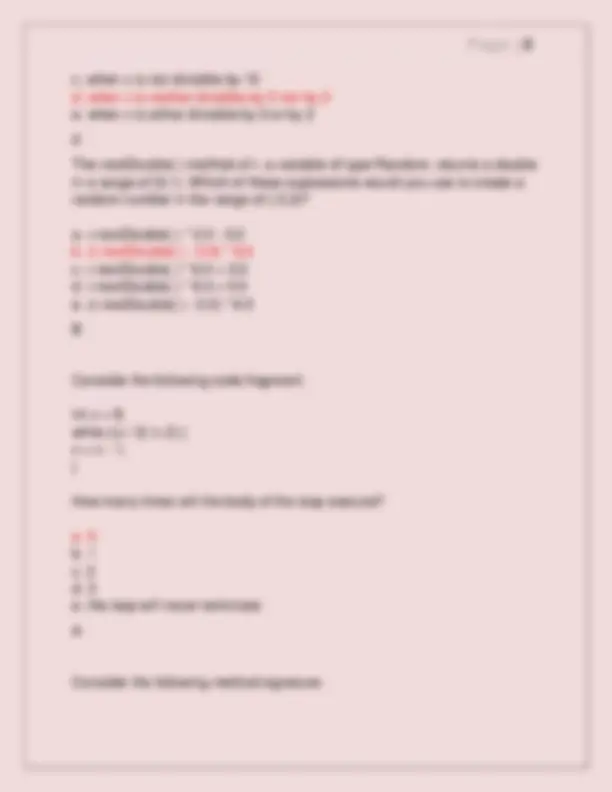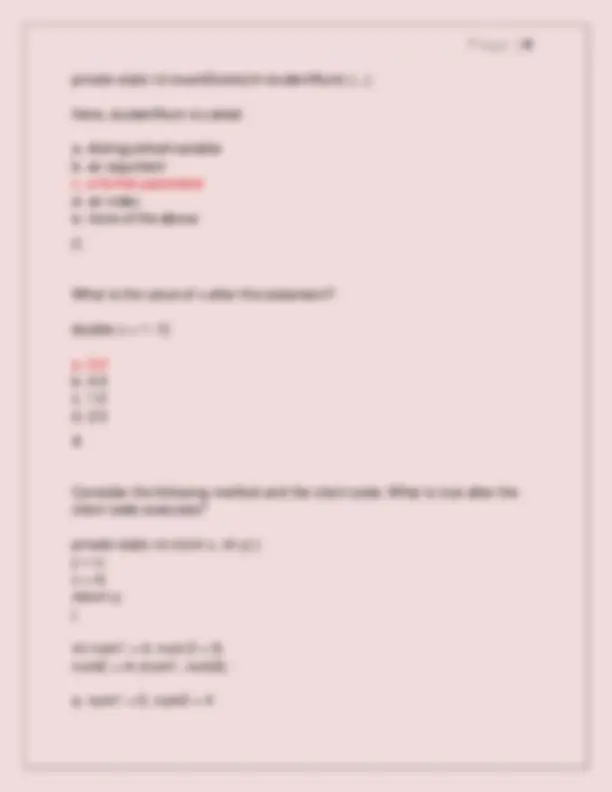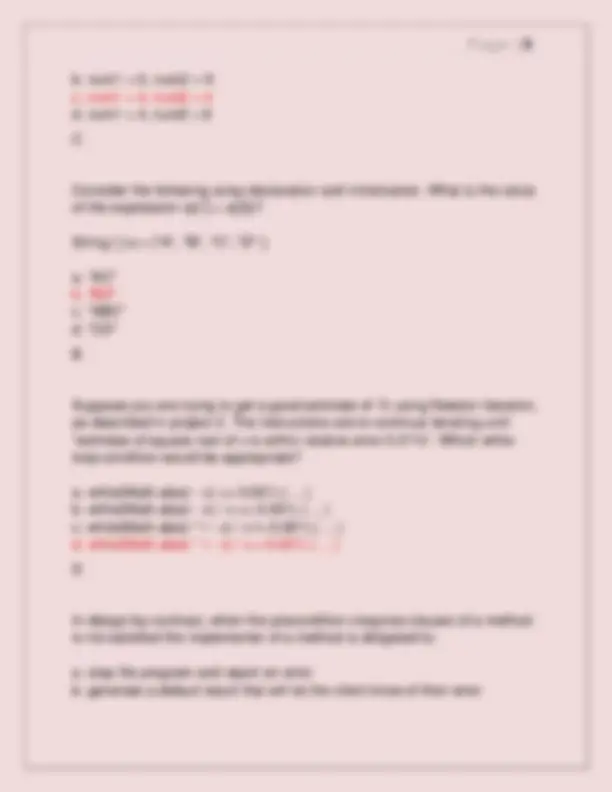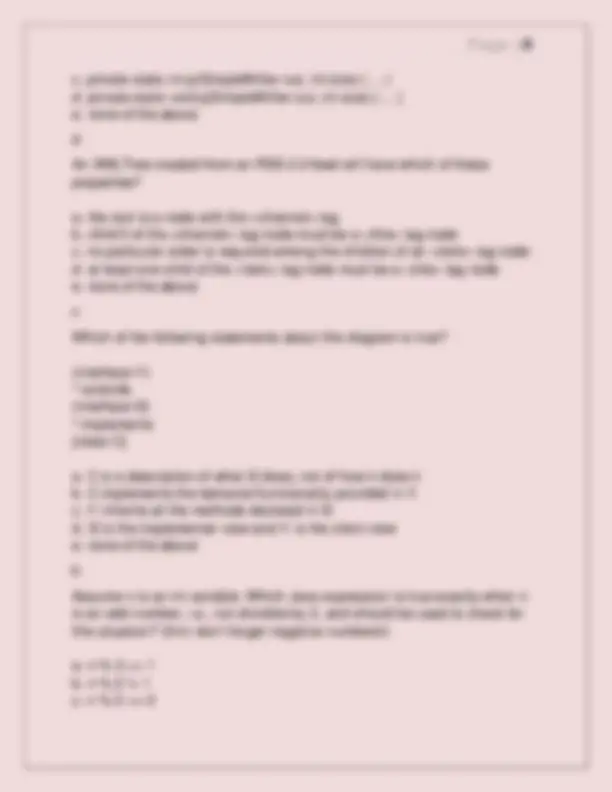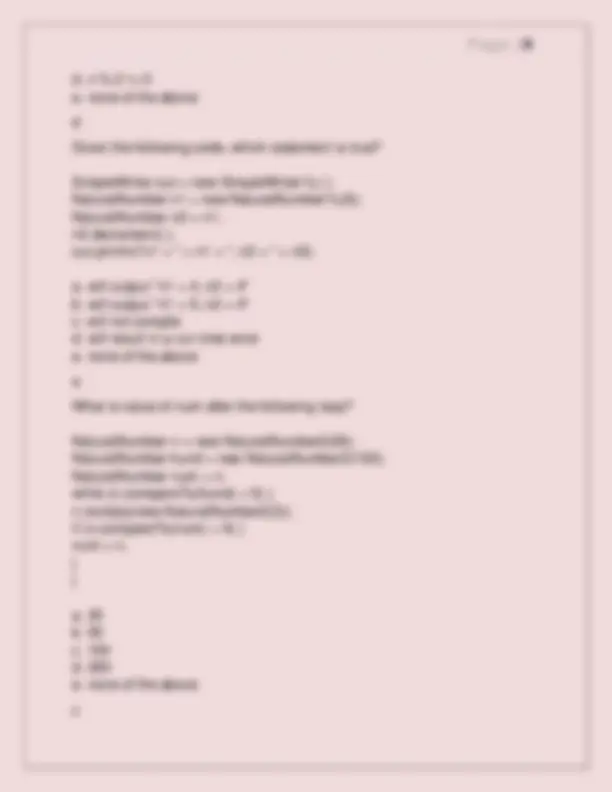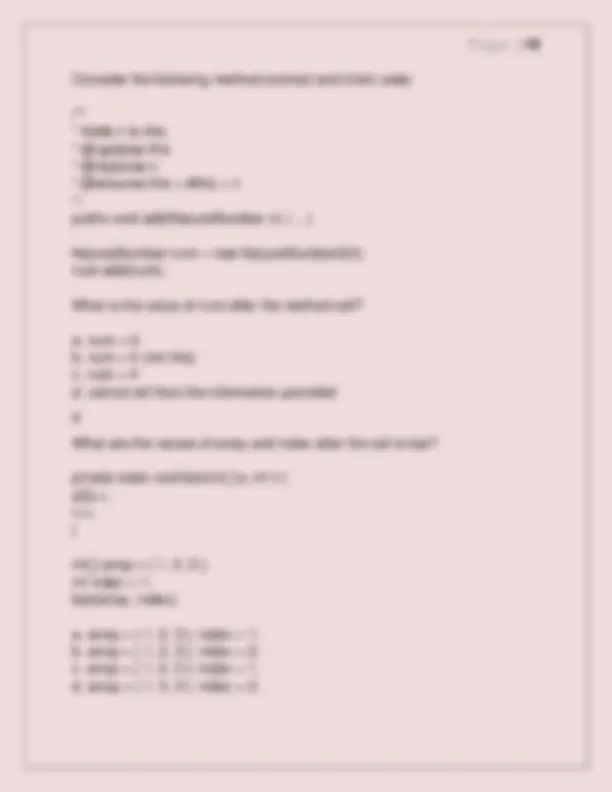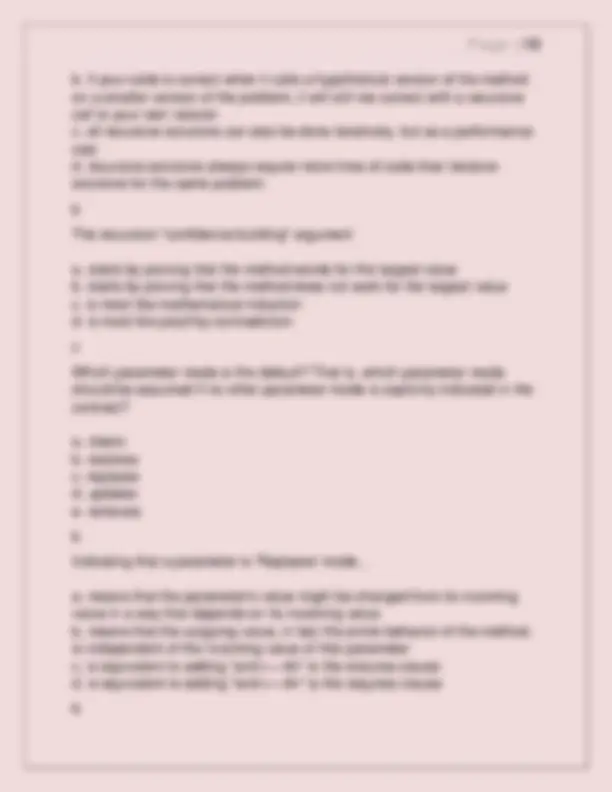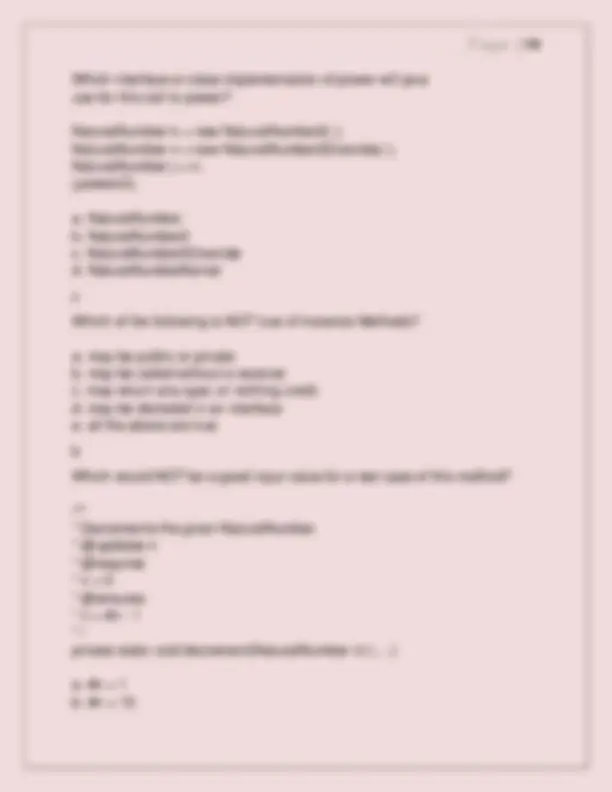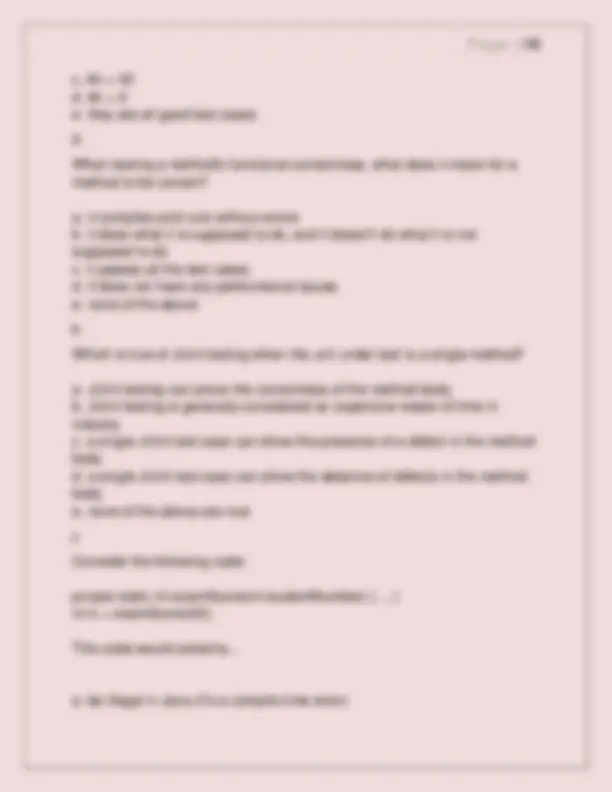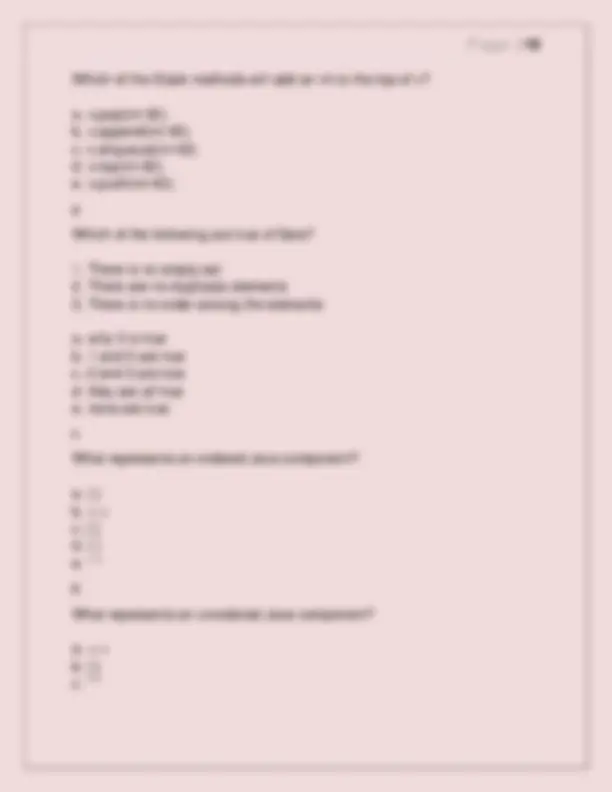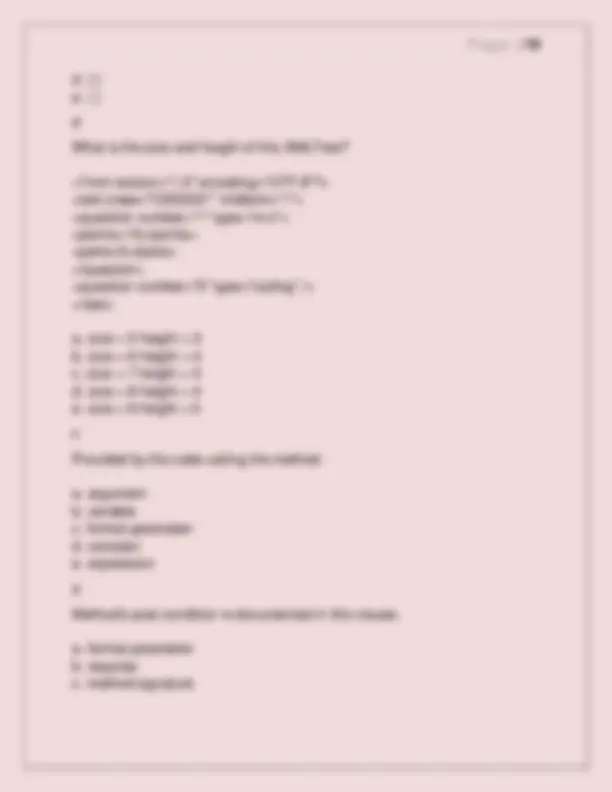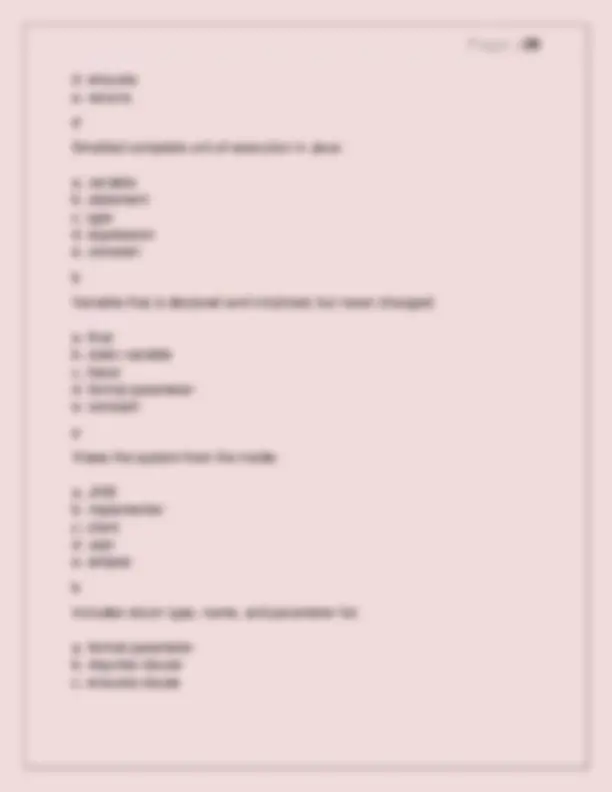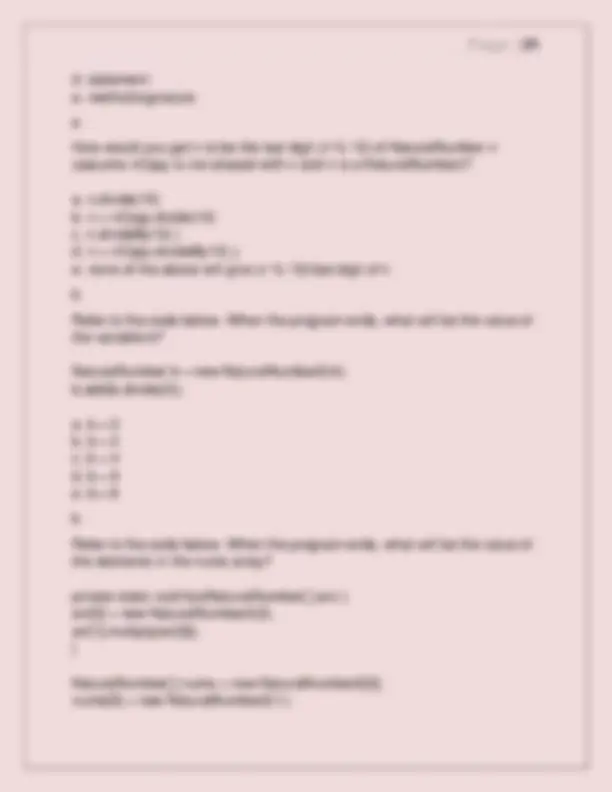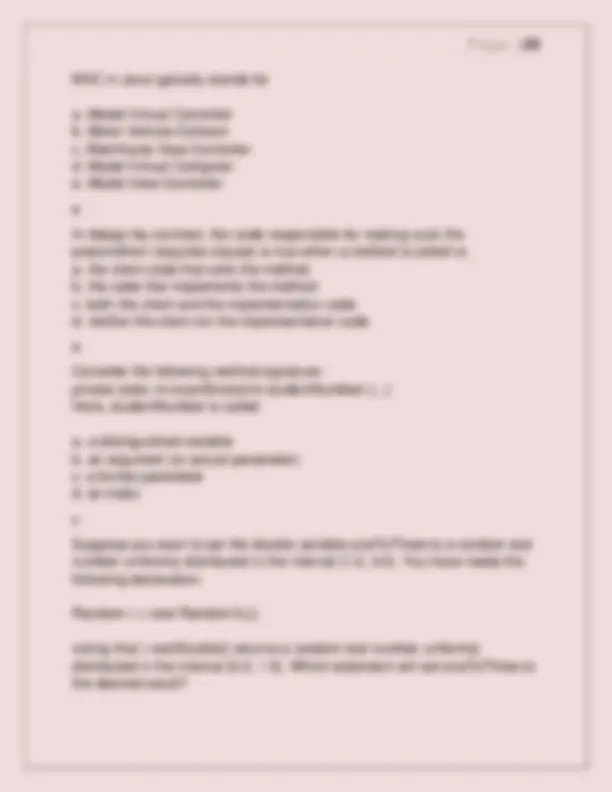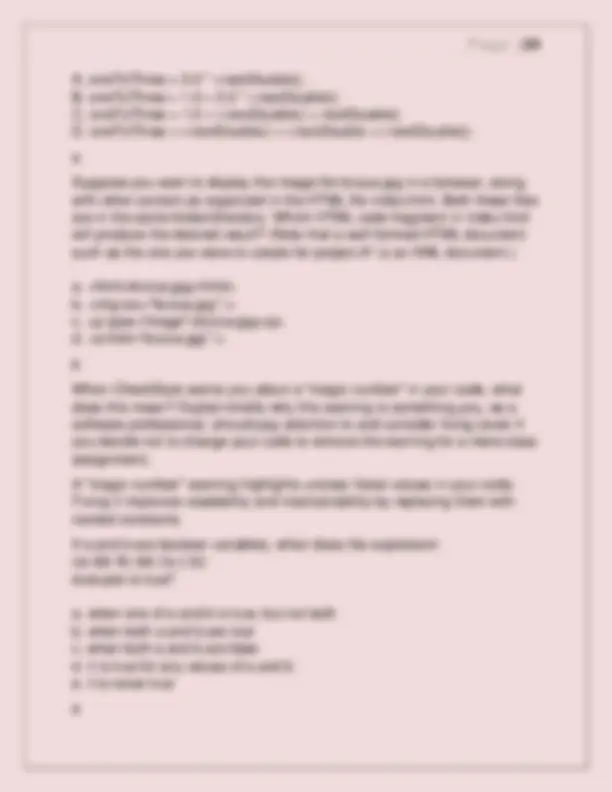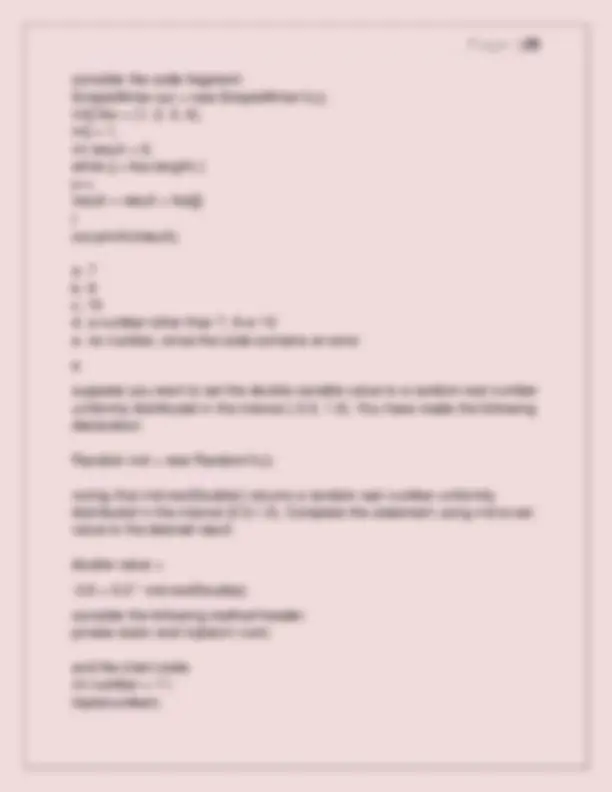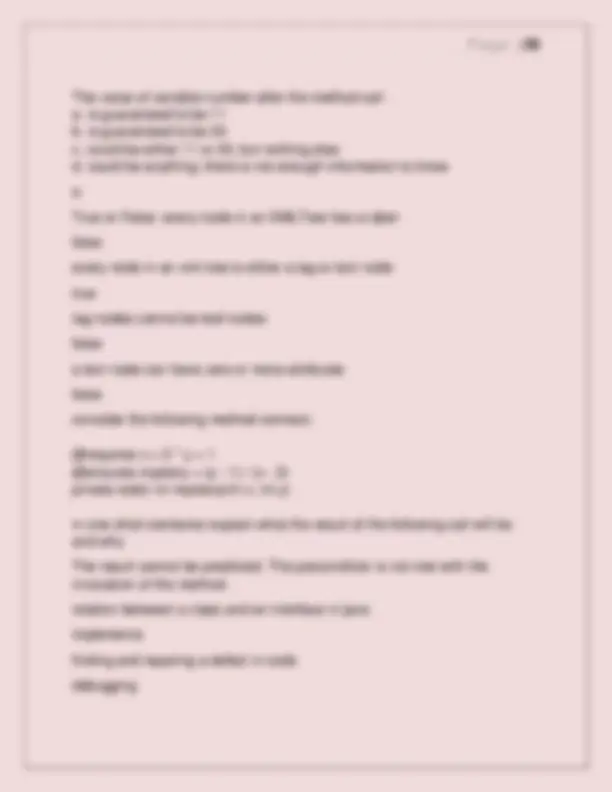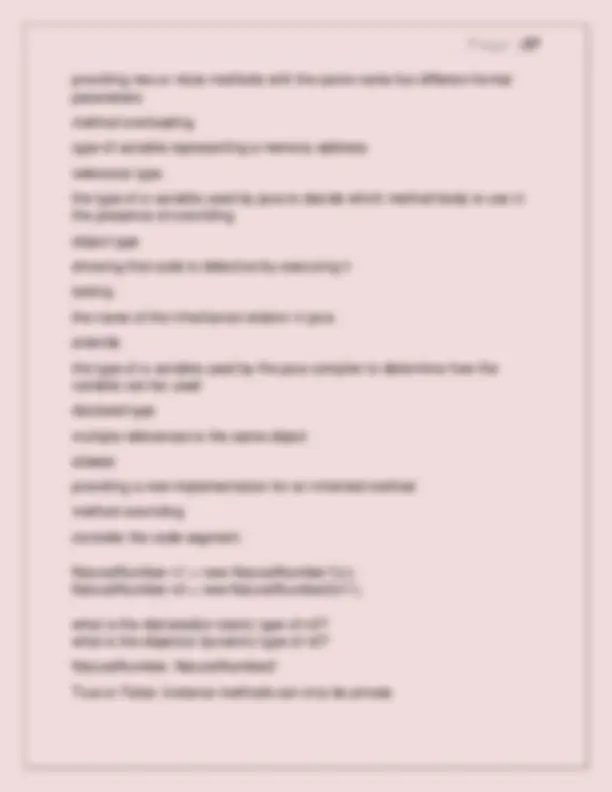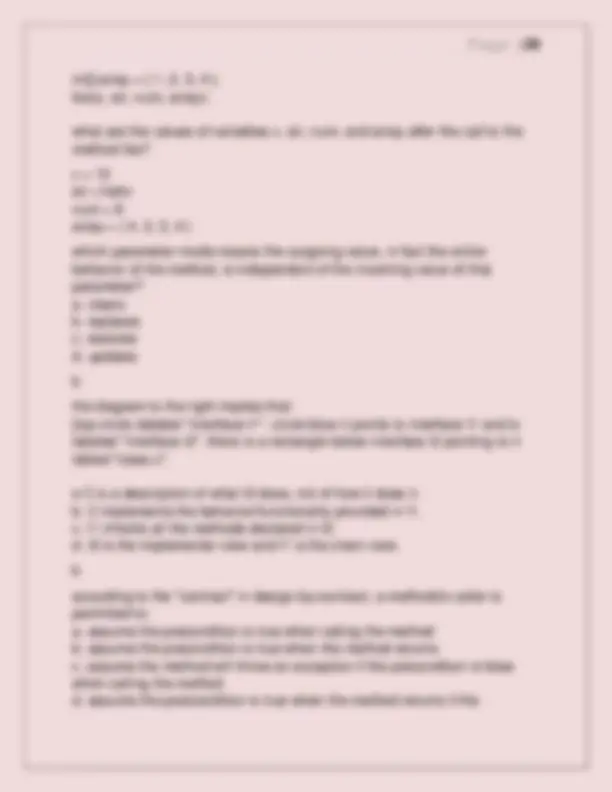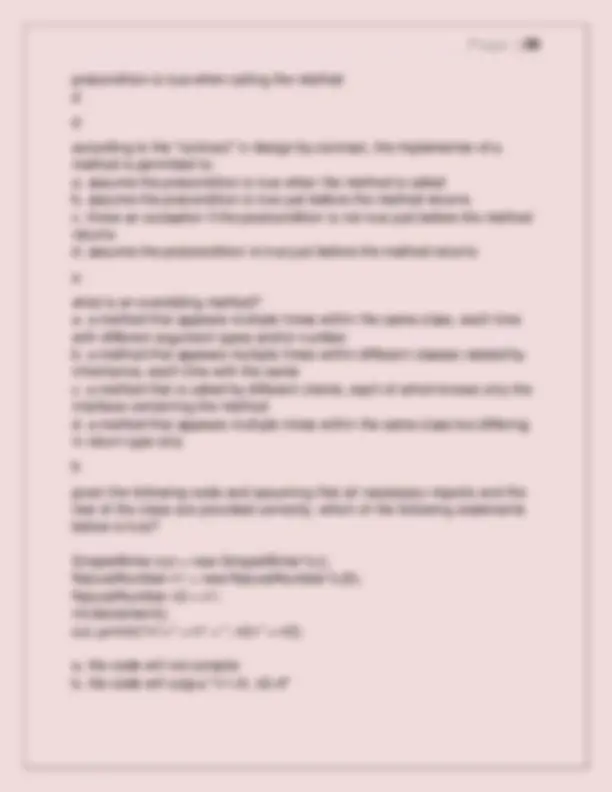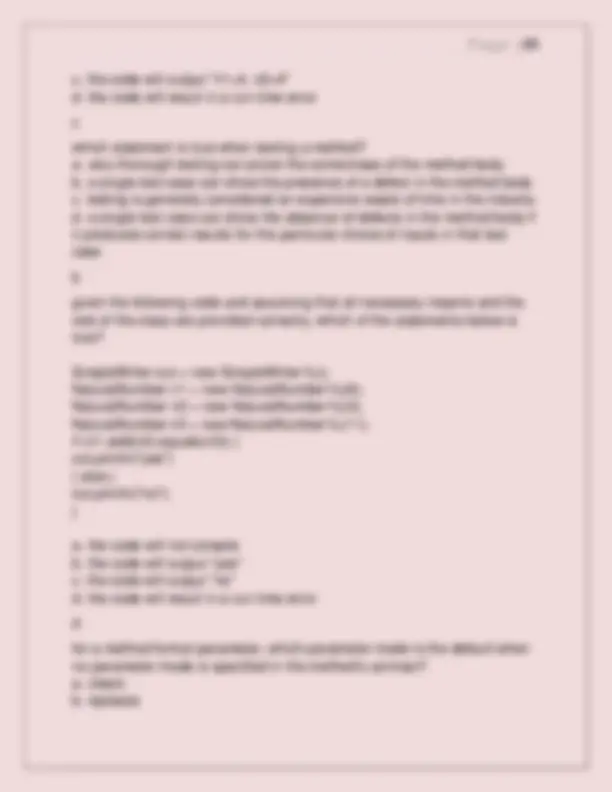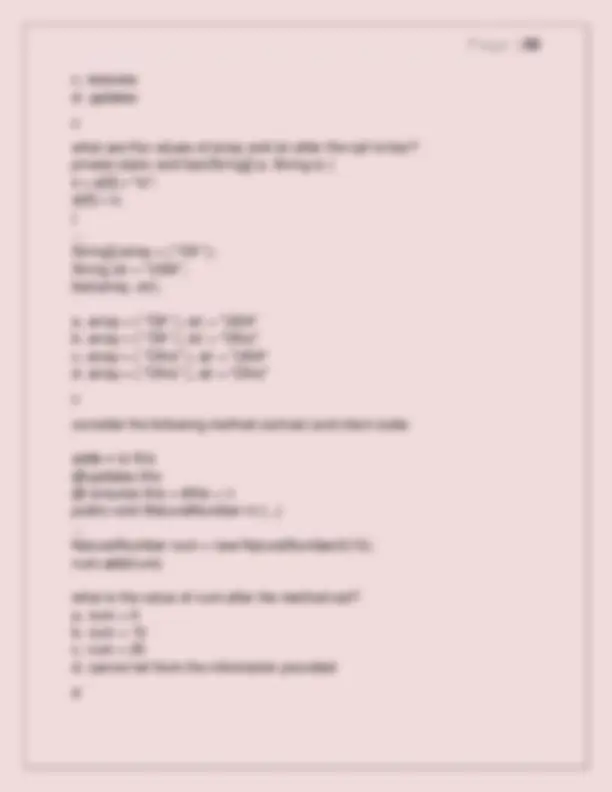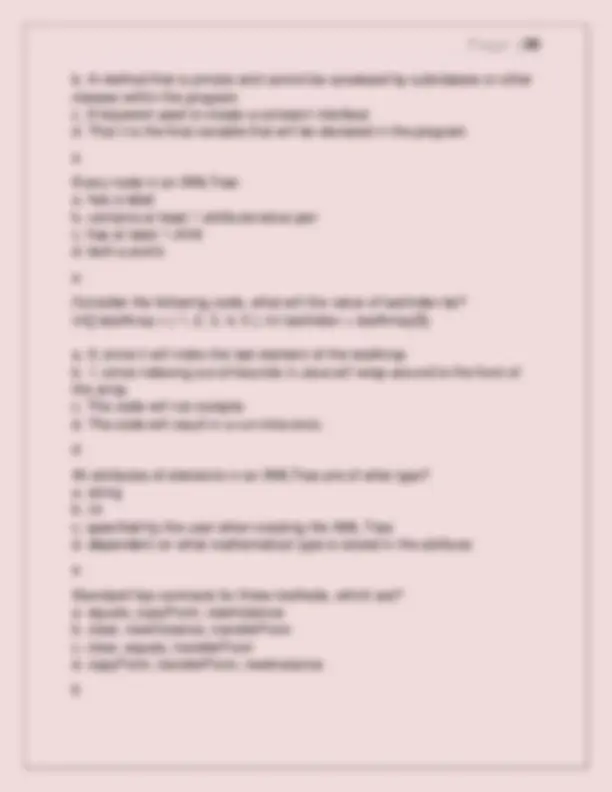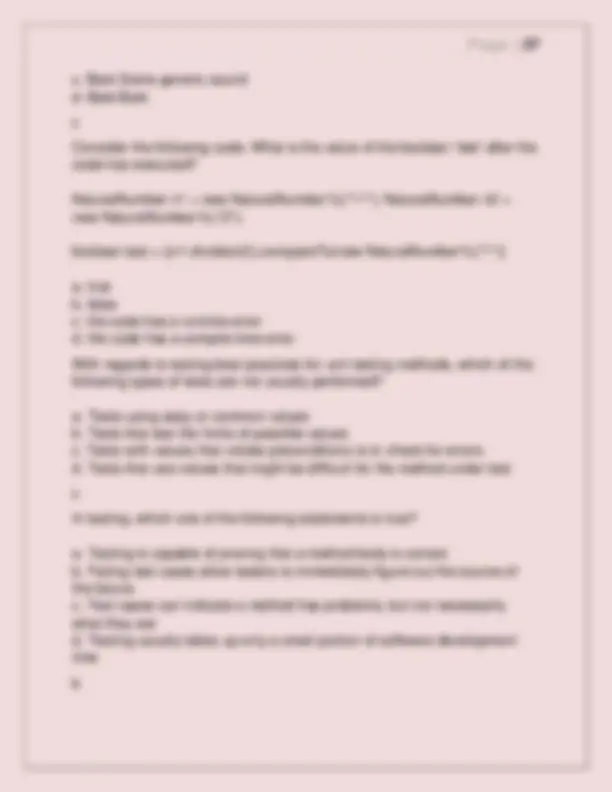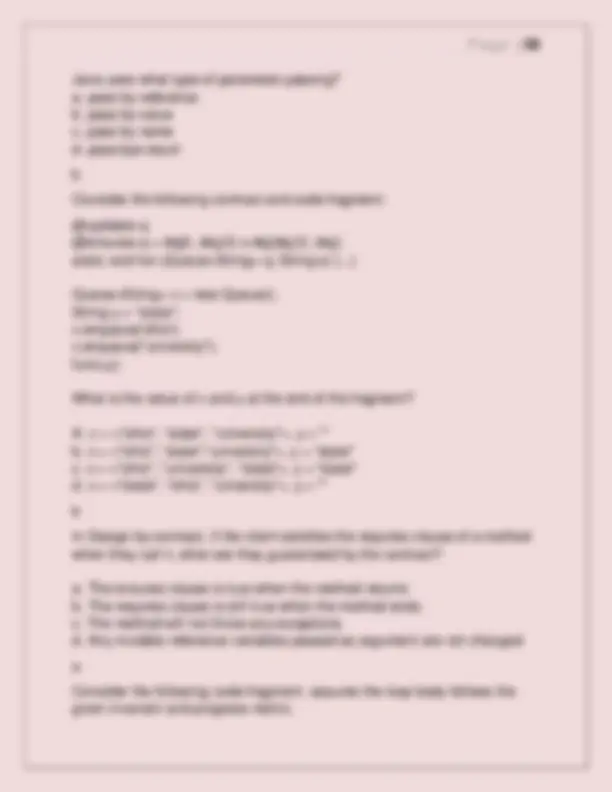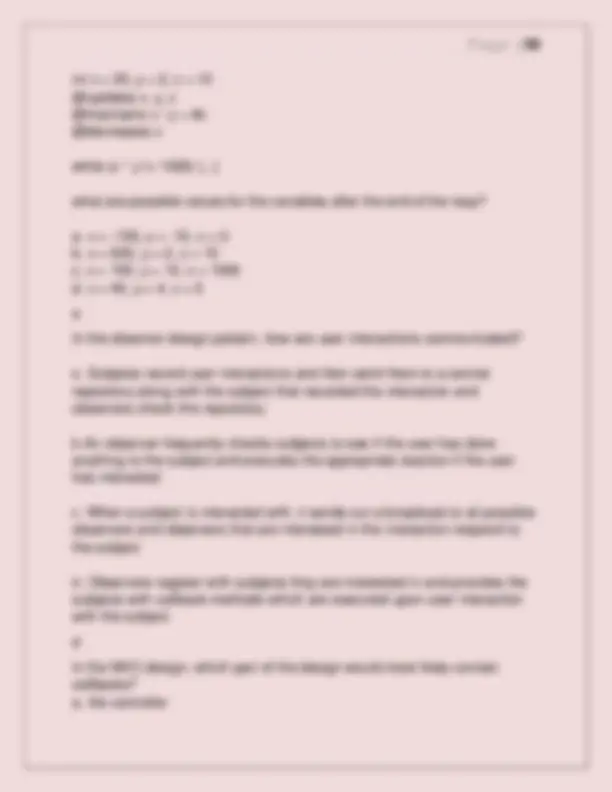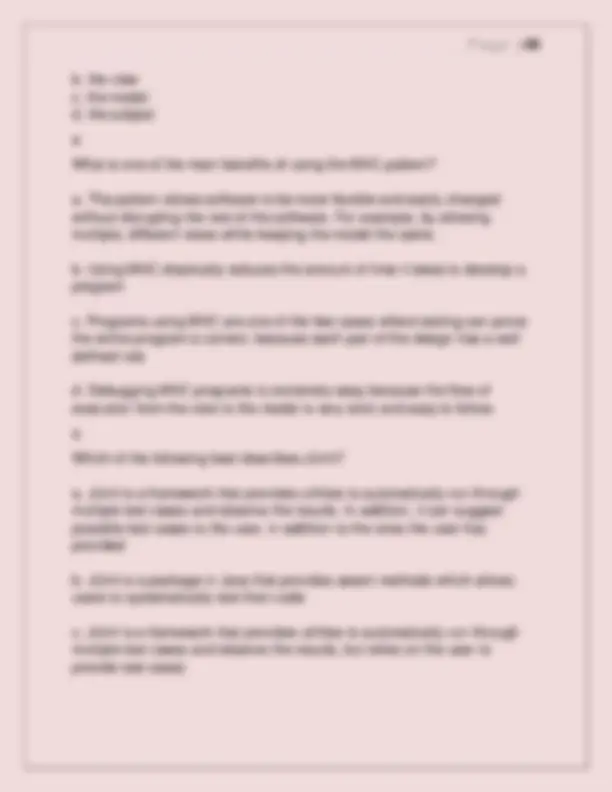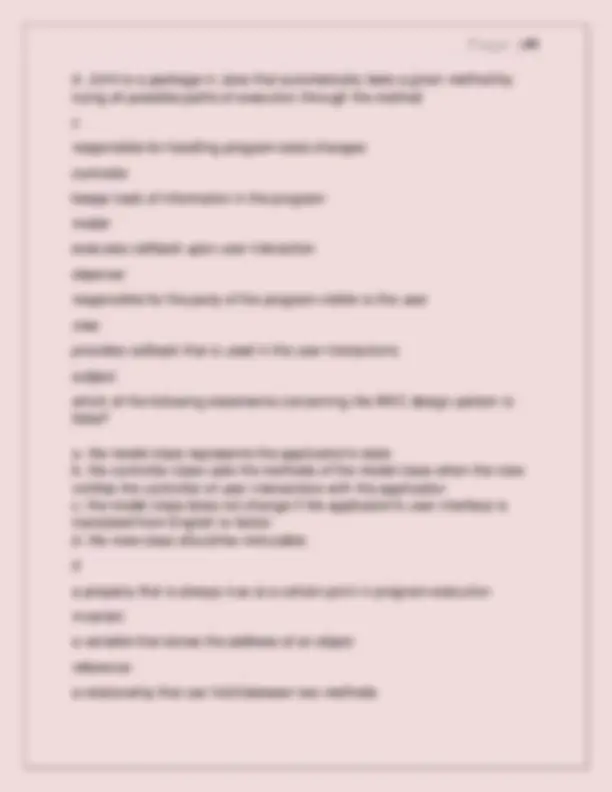Download OSU CSE 2221 Final Review: Java Programming Multiple Choice Questions and Answers and more Exams Design Patterns in PDF only on Docsity!
OSU CSE 2221 FINAL REVIEW NEW 2025 /2026 |
BRAND NEW ACTUAL EXAM WITH QUESTIONS
AND CORRECT ANSWERS
The correct syntax for the "main" method signature is: a. private static void main(String[] args) b. public static String main(String[] args) c. public static void main(String[] args) d. public void main(String[] args) e. none of the above c The Java compiler does the following: a. checks a bytecode program in a ".class" file for run-time errors and if there are none, it generates source code for that program in a ".java" file b. checks a source code program in a ".java" file for run-time errors and if there are none, it generates bytecode for that program in a ".class" file c. checks a source code program in a ".java" file for compile-time errors and, if there are none, it generates bytecode for that program in a ".class" file d. checks a bytecode program in a ".class" file for compile-time errors and if there are none, it generates source code for that program in a ".java" file e. none of the above C Which statement correctly defines a java constant? a. const SPECIAL = 1234;
b. int SPECIAL = 1234; c. int final SPECIAL = 1234; d. final int SPECIAL = 1234; e. const int SPECIAL = 1234; D What is the value of s after the following statement: String s = (!true) + " : " + (10 + 4) + " is 104"; a. "!true : 104 is 104" b. "false : 104 is 104" c. "!true : 14 is 104" d. "false : 14 is 104" e. This is a compile-time error D The Checkstyle plugin for Eclipse is useful because: a. it warns you of potential compile-time errors b. it helps you make your code understandable for yourself and other programmers c. it prevents your code from making errors caught by assert statements d. it tells you when code you have written does not obey its contract e. none of the above B If x is an int variable, when does the boolean expression evaluate to true? ((x % 5 != 0) && (x % 2 != 0)) a. when x is divisible by 5 or by 2 but not by both b. when x is divisible by 10
private static int examScore(int studentNum) {...} Here, studentNum is called: a. distinguished variable b. an argument c. a formal parameter d. an index e. none of the above C What is the value of x after this statement? double x = 1 / 2; a. 0. b. 0. c. 1. d. 2. A Consider the following method and the client code. What is true after the client code executes? private static int m(int x, int y) { y = x; x = 0; return y; } int num1 = 4, num 2 = 9; num2 = m (num1, num2); a. num1 = 0, num2 = 4
b. num1 = 0, num2 = 9 c. num1 = 4, num2 = 4 d. num1 = 4, num2 = 9 C Consider the following array declaration and initialization. What is the value of the expression (a[1] + a[3])? String [ ] a = {"A", "B", "C", "D" }; a. "AC" b. "BD" c. "ABC" d. "CD" B Suppose you are trying to get a good estimate of √x using Newton Iteration, as described in project 2. The instructions are to continue iterating until "estimate of square root of x is within relative error 0.01%". Which while loop condition would be appropriate? a. while(Math.abs(r - x) >= 0.001) { ... } b. while(Math.abs(r - x) / x >= 0.001) { ... } c. while(Math.abs(r * r - x) / x != 0.001) { ... } d. while(Math.abs(r * r - x) / x > 0.001) { ... } D In design-by-contract, when the precondition (requires clause) of a method is not satisfied the implementer of a method is obligated to: a. stop the program and report an error b. generate a default result that will let the client know of their error
c Which is NOT a property of an RSS 2.0 feed? a. the root is an rss node with a version attribute whose value is "2.0" b. there are one or more channel nodes as a child of the root c. the channel node must have one of each of these nodes as children: title, link, and description d. the channel node can also have zero or more item child nodes plus other optional children e. all the above are true for RSS 2. b What can you say about these two methods m1 & m2? private static boolean m1(int x, int y) { boolean result; if (x>0 && y > 0) { result = false; } else { result = true; } return result; } private static boolean m2(int x, int y) { return !(x > 0 && y > 0); } a. both return the same result for all values of x and y b. they return different values of x and y c. m1 contains syntax errors d. m2 contains syntax errors e. both have syntax errors a Which is an appropriate method signature for a method p that will print a square of dollar signs ($) with a given output stream, and a given size of the square? a. private static SimpleWriter p(int size, "$") { ... } b. private static void p(out, size) { ... }
c. private static int p(SimpleWriter out, int size) { ... } d. private static void p(SimpleWriter out, int size) { ... } e. none of the above d An XMLTree created from an RSS 2.0 feed will have which of these properties? a. the root is a node with the tag b. child 0 of the tag node must be a tag node c. no particular order is required among the children of an <item> tag node d. at least one child of the <item> tag node must be a <title> tag node e. none of the above c Which of the following statements about this diagram is true? (interface I1) ^ extends (interface I2) ^ implements [class C] a. C is a description of what I2 does, not of how it does it b. C implements the behavior/functionality provided in I c. I1 inherits all the methods declared in I d. I2 is the implementer view and I1 is the client view e. none of the above b Assume n is an int variable. Which Java expression is true exactly when n is an odd number, i.e., not divisible by 2, and should be used to check for this situation? (hint: don't forget negative numbers!) a. n % 2 == 1 b. n % 2 != 1 c. n % 2 == 0</p> <p>Consider the following method contract and client code: /**</p> <ul> <li>Adds n to this.</li> <li>@updates this</li> <li>@restores n</li> <li>@ensures this = #this + n */ public void add(NaturalNumber n) { ... } NaturalNumber num = new NaturalNumber2(2); num.add(num); What is the value of num after the method call? a. num = 0 b. num = 2 (not this) c. num = 4 d. cannot tell from the information provided d What are the values of array and index after the call to bar? private static void bar(int[ ] a, int i) { a[i]++; i++; } int[ ] array = { 1, 2, 3 }; int index = 1; bar(array, index); a. array = { 1, 2, 3 }; index = 1; b. array = { 1, 2, 3 }; index = 2; c. array = { 1, 3, 3 }; index = 1; d. array = { 1, 3, 3 }; index = 2;</li> </ul> <p>c What will be the value of the array after this code executes? NaturalNumber[ ] array = new NaturalNumber2[4]; NaturalNumber count = new NaturalNumber2(1); for (int i = 0; i < array.length; i++) { array[i].copyFrom(count); count.increment( ); } a. array = { 0, 0, 0, 0 } b. array = { 1, 2, 3, 4 } c. array = { 4, 4, 4, 4 } d. there is an error in the code that will cause a runtime error d What line of code is missing from this method? private static int size(XMLTree t) { int totalNodes = 1; [ ] // missing line for (int i = 0; i < t.numberOfChildren( ); i++) { totalNodes += size(t.child(i)); } } return totalNodes; } a. if (t.numberOfChildren( ) > 0) { b. if (!t.label( ).equals("")) { c. if (!t.isTag( )) { d. if (t.isTag( )) { d After the two variables are declared and initialized, which java instruction will set the value of b to true?</p> <p>b. if your code is correct when it calls a hypothetical version of the method on a smaller version of the problem, it will still me correct with a recursive call to your own version c. all recursive solutions can also be done iteratively, but as a performance cost d. recursive solutions always require more lines of code than iterative solutions for the same problem b The recursion "confidence building" argument a. starts by proving that the method words for the largest value b. starts by proving that the method does not work for the largest value c. is most like mathematical induction d. is most like proof by contradiction c Which parameter mode is the default? That is, which parameter mode should be assumed if no other parameter mode is explicitly indicated in the contract? a. clears b. restores c. replaces d. updates e. removes b Indicating that a parameter is 'Replaces' mode... a. means that the parameter's value might be changed from its incoming value in a way that depends on its incoming value b. means that the outgoing value, in fact the entire behavior of the method, is independent of the incoming value of that parameter c. is equivalent to adding "and x = #x" to the ensures clause d. is equivalent to adding "and x = #x" to the requires clause b</p> <p>Which interface or class implementation of power will java use for this call to power? NaturalNumber k = new NaturalNumber2( ); NaturalNumber n = new NaturalNumber2Override( ); NaturalNumber j = n; j.power(2); a. NaturalNumber b. NaturalNumber c. NaturalNumber2Override d. NaturalNumberKernel c Which of the following is NOT true of Instance Methods? a. may be public or private b. may be called without a receiver c. may return any type, or nothing (void) d. may be declared in an interface e. all the above are true b Which would NOT be a good input value for a test case of this method? /**</p> <ul> <li>Decrements the given NaturalNumber.</li> <li>@updates n</li> <li>@requires</li> <li>n > 0</li> <li>@ensures</li> <li>n = #n - 1</li> <li>/ private static void decrement(NaturalNumber n) { ... } a. #n = 1 b. #n = 10</li> </ul> <p>b. cause the program to crash when it is executed (it is a run-time error) c. print out the exam score of student # d. assign an exam score of 42 to student k e. be legal in Java (though flagged by Checkstyle) e You may reason about the behavior of Java code involving immutable types exactly as if they were primitive types because: a. "Immutable" and "primitive" are synonyms; there is no difference between them b. computations involving immutable types are just as efficient as those involving primitive types c. aliasing, which can happen with immutable types but not primitive types, cannot cause trouble because object values for immutable types cannot be changed d. in any code where an immutable type is used in a way where it would not behave like a primitive type, it causes a Java compile-time error c What are the values of str and num after the call to foo? private static void foo(String s, NaturalNumber n) { s = "Columbus, " +s; n = new NaturalNumber2(43210); } String str = "Ohio"; NaturalNumber num = new NaturalNumber2(314); foo(str, num); a. str="Ohio", num= b. str="Columbus, Ohio", num= c. str="Ohio", num= d. str="Columbus, Ohio", num= c</p> <p>A type is an immutable type if: a. it is illegal to copy a reference of that type, so there can be no aliasing b. for every instance method of that type, this and every other parameter of that type is a restores-mode parameter c. that type has a no-argument constructor d. a function method may not return a result of that type b JVM stands for: a. Java Virtual Manager b. Java Virtual Memory c. Java Virtual Machine d. Java Variable Mathematics e. none of the above c API stands for: a. Advanced Programming Index b. Advanced Power Interface c. Access Port Input d. Application Personal Interface e. Application Programming Interface e Which four Javadoc tags are required for this method? private static double sqrt(double x) { ... } a. @param, @return, @updates b. @param, @return, @replaces c. @author, @version, @return d. @param, @return, @ensures d</p> <p>d. { } e. ( ) d What is the size and height of this XMLTree?</p> <?xml version="1.0" encoding="UTF-8"?> <test class="CSE2221" midterm="1"> <question number="1" type="m-c"> <points>15</points> <parts>5</parts> </question> <question number="5" type="coding" /> </test> a. size = 5 height = 3 b. size = 6 height = 4 c. size = 7 height = 5 d. size = 8 height = 4 e. size = 6 height = 5 c Provided by the code calling the method: a. argument b. variable c. formal parameter d. constant e. expression a Method's post condition is documented in this clause: a. formal parameter b. requires c. method signature <p>d. ensures e. returns d Smallest complete unit of execution in Java: a. variable b. statement c. type d. expression e. constant b Variable that is declared and initialized, but never changed: a. final b. static variable c. literal d. formal parameter e. constant e Views the system from the inside: a. JVM b. implementer c. client d. user e. eclipse b Includes return type, name, and parameter list: a. formal parameter b. requires clause c. ensures clause</p> </div></div></div></div><footer id="footer" class="sc-gsnTZi hxUvtc"><div width="100%" display="grid" class="sc-gsnTZi sc-breuTD hQDdiS cEXOWE"><div class="sc-gsnTZi sc-ksZaOG hINUYJ ijDdyb"><p color="muted" class="sc-dkzDqf jtFJUi">Documents</p><div width="100%" display="grid" class="sc-gsnTZi sc-breuTD jxbiSy ddZtgY"><div class="sc-gsnTZi sc-ksZaOG hINUYJ dPsdkt"><a href="/en/summaries/" color="negative" class="sc-dkzDqf liUIpz">Summaries</a></div><div class="sc-gsnTZi sc-ksZaOG hINUYJ dPsdkt"><a href="/en/exercises/" color="negative" class="sc-dkzDqf liUIpz">Exercises</a></div><div class="sc-gsnTZi sc-ksZaOG hINUYJ dPsdkt"><a href="/en/exam-questions/" color="negative" class="sc-dkzDqf liUIpz">Exam</a></div><div class="sc-gsnTZi sc-ksZaOG hINUYJ dPsdkt"><a href="/en/lecture-notes/" color="negative" class="sc-dkzDqf liUIpz">Lecture notes</a></div><div class="sc-gsnTZi sc-ksZaOG hINUYJ dPsdkt"><a href="/en/degree-thesis/" color="negative" class="sc-dkzDqf liUIpz">Thesis</a></div><div class="sc-gsnTZi sc-ksZaOG hINUYJ dPsdkt"><a href="/en/study-notes/" color="negative" class="sc-dkzDqf liUIpz">Study notes</a></div><div class="sc-gsnTZi sc-ksZaOG hINUYJ dPsdkt"><a href="/en/schemes/" color="negative" class="sc-dkzDqf liUIpz">Schemes</a></div><div class="sc-gsnTZi sc-ksZaOG hINUYJ dPsdkt"><a href="/en/store/" color="negative" class="sc-dkzDqf liUIpz">Document Store</a></div><div class="sc-gsnTZi sc-ksZaOG hINUYJ dPsdkt"><a href="/en/documents/" color="negative" text-decoration="underline" class="sc-dkzDqf jvXOLr">View all</a></div></div></div><div class="sc-gsnTZi sc-ksZaOG hINUYJ ijDdyb"><p color="muted" class="sc-dkzDqf jtFJUi">questions</p><div width="100%" display="grid" class="sc-gsnTZi sc-breuTD jxbiSy ddZtgY"><div class="sc-gsnTZi sc-ksZaOG hINUYJ dPsdkt"><a href="/en/answers/" color="negative" class="sc-dkzDqf liUIpz">Latest questions</a></div><div class="sc-gsnTZi sc-ksZaOG hINUYJ dPsdkt"><a href="/en/answers/biology-and-chemistry/" color="negative" class="sc-dkzDqf liUIpz">Biology and Chemistry</a></div><div class="sc-gsnTZi sc-ksZaOG hINUYJ dPsdkt"><a href="/en/answers/psicology-and-sociology/" color="negative" class="sc-dkzDqf liUIpz">Psychology and Sociology</a></div><div class="sc-gsnTZi sc-ksZaOG hINUYJ dPsdkt"><a href="/en/answers/management/" color="negative" class="sc-dkzDqf liUIpz">Management</a></div><div class="sc-gsnTZi sc-ksZaOG hINUYJ dPsdkt"><a href="/en/answers/physics/" color="negative" class="sc-dkzDqf liUIpz">Physics</a></div></div></div><div class="sc-gsnTZi sc-ksZaOG hINUYJ ijDdyb"><p color="muted" class="sc-dkzDqf jtFJUi">University</p><div width="100%" display="grid" class="sc-gsnTZi sc-breuTD jxbiSy ddZtgY"><div class="sc-gsnTZi sc-ksZaOG hINUYJ dPsdkt"><a href="/en/university/us/" color="negative" class="sc-dkzDqf liUIpz">United States of America (USA)</a></div><div class="sc-gsnTZi sc-ksZaOG hINUYJ dPsdkt"><a href="/en/university/ph/" color="negative" class="sc-dkzDqf liUIpz">Philippines</a></div><div class="sc-gsnTZi sc-ksZaOG hINUYJ dPsdkt"><a href="/en/university/in/" color="negative" class="sc-dkzDqf liUIpz">India</a></div><div class="sc-gsnTZi sc-ksZaOG hINUYJ dPsdkt"><a href="/en/university/vn/" color="negative" class="sc-dkzDqf liUIpz">Vietnam</a></div><div class="sc-gsnTZi sc-ksZaOG hINUYJ dPsdkt"><a href="/en/university/gb/" color="negative" class="sc-dkzDqf liUIpz">United Kingdom</a></div><div class="sc-gsnTZi sc-ksZaOG hINUYJ dPsdkt"><a href="/en/university/ca/" color="negative" class="sc-dkzDqf liUIpz">Canada</a></div><div class="sc-gsnTZi sc-ksZaOG hINUYJ dPsdkt"><a href="/en/university/tr/" color="negative" class="sc-dkzDqf liUIpz">Turkey</a></div><div class="sc-gsnTZi sc-ksZaOG hINUYJ dPsdkt"><a href="/en/university/id/" color="negative" class="sc-dkzDqf liUIpz">Indonesia</a></div></div></div></div><div class="sc-gsnTZi dfEwCf"><img src="https://assets.docsity.com/ds/logo/docsity-logo-rebrand-negativo.svg" alt="Docsity logo" width="269px" height="120px" class="sc-crXcEl kmMsfS"/></div><div direction="row" class="sc-bczRLJ iznJYF"><a color="negative" target="_self" href="/en/ai/explore-ai/" class="sc-dkzDqf liUIpz">Docsity AI</a><a color="negative" target="_self" href="/en/store/sell/" class="sc-dkzDqf liUIpz">Sell documents</a><a color="negative" target="_blank" href="https://corporate.docsity.com/about-us/" class="sc-dkzDqf liUIpz">About us</a><a color="negative" target="_blank" href="https://support.docsity.com/hc/en-us" class="sc-dkzDqf liUIpz">Contact us</a><a color="negative" target="_blank" href="https://corporate.docsity.com/docsity-partners/" class="sc-dkzDqf liUIpz">Partners</a><a color="negative" target="_self" href="/en/pag/how-does-docsity-works/" class="sc-dkzDqf liUIpz">How does Docsity work</a><a color="negative" target="_blank" href="https://weuni.docsity.com/en/" class="sc-dkzDqf liUIpz">WeUni</a></div><div class="sc-gsnTZi bNTXbI"><div direction="row" class="sc-bczRLJ iznJYF"><a color="negative" target="_self" href="/es/documentos/" class="sc-dkzDqf liUIpz">Español</a><a color="negative" target="_self" href="/it/documenti/" class="sc-dkzDqf liUIpz">Italiano</a><a color="negative" target="_self" href="/en/documents/" class="sc-dkzDqf liUIpz">English</a><a color="negative" target="_self" href="/sr/dokumenta/" class="sc-dkzDqf liUIpz">Srpski</a><a color="negative" target="_self" href="/pl/dokumenty/" class="sc-dkzDqf liUIpz">Polski</a><a color="negative" target="_self" href="/ru/dokumenty/" class="sc-dkzDqf liUIpz">Русский</a><a color="negative" target="_self" href="/pt/documentos/" class="sc-dkzDqf liUIpz">Português</a><a color="negative" target="_self" href="/fr/documents/" class="sc-dkzDqf liUIpz">Français</a><a color="negative" target="_self" href="/de/dokumente/" class="sc-dkzDqf liUIpz">Deutsch</a></div></div><div class="sc-gsnTZi fHZVwh"><div direction="row" class="sc-bczRLJ iznJYF"><a color="negative" target="_self" href="/en/usa/" class="sc-dkzDqf liUIpz">United States of America (USA)</a><a color="negative" target="_self" href="/en/phl/" class="sc-dkzDqf liUIpz">Philippines</a><a color="negative" target="_self" href="/en/ind/" class="sc-dkzDqf liUIpz">India</a><a color="negative" target="_self" href="/en/vnm/" class="sc-dkzDqf liUIpz">Vietnam</a><a color="negative" target="_self" href="/en/gbr/" class="sc-dkzDqf liUIpz">United Kingdom</a><a color="negative" target="_self" href="/en/can/" class="sc-dkzDqf liUIpz">Canada</a><a color="negative" target="_self" href="/en/tur/" class="sc-dkzDqf liUIpz">Turkey</a><a color="negative" target="_self" href="/en/idn/" class="sc-dkzDqf liUIpz">Indonesia</a></div></div><div display="flex" class="sc-gsnTZi gCHycu"><div direction="row" class="sc-bczRLJ iznJYF"><a color="negative" target="_self" href="/en/pag/terms-and-conditions/" class="sc-dkzDqf liUIpz">Terms of Use</a><a color="negative" target="_self" href="/en/pag/cookie-policy/" class="sc-dkzDqf liUIpz">Cookie Policy</a><button color="negative" target="_self" class="sc-dkzDqf liUIpz">Cookie setup</button><a color="negative" target="_self" href="/en/pag/privacy/" class="sc-dkzDqf liUIpz">Privacy Policy</a></div><div direction="row" class="sc-bczRLJ iznJYF"><a href="https://www.facebook.com/DocsityGlobal" target="_blank" aria-label="facebook" color="inherit" class="sc-dkzDqf kUmfEV"><span class="sc-cxabCf kOzcVX"><svg xmlns="http://www.w3.org/2000/svg" width="1em" height="1em" fill="currentColor" viewBox="0 0 256 256"><path d="M128,20A108,108,0,1,0,236,128,108.12,108.12,0,0,0,128,20Zm12,191.13V156h20a12,12,0,0,0,0-24H140V112a12,12,0,0,1,12-12h16a12,12,0,0,0,0-24H152a36,36,0,0,0-36,36v20H96a12,12,0,0,0,0,24h20v55.13a84,84,0,1,1,24,0Z"></path></svg></span></a><a href="https://www.instagram.com/docsity_en/" target="_blank" aria-label="instagram" color="inherit" class="sc-dkzDqf kUmfEV"><span class="sc-cxabCf kOzcVX"><svg xmlns="http://www.w3.org/2000/svg" width="1em" height="1em" fill="currentColor" viewBox="0 0 256 256"><path d="M128,80a48,48,0,1,0,48,48A48.05,48.05,0,0,0,128,80Zm0,72a24,24,0,1,1,24-24A24,24,0,0,1,128,152ZM176,20H80A60.07,60.07,0,0,0,20,80v96a60.07,60.07,0,0,0,60,60h96a60.07,60.07,0,0,0,60-60V80A60.07,60.07,0,0,0,176,20Zm36,156a36,36,0,0,1-36,36H80a36,36,0,0,1-36-36V80A36,36,0,0,1,80,44h96a36,36,0,0,1,36,36ZM196,76a16,16,0,1,1-16-16A16,16,0,0,1,196,76Z"></path></svg></span></a><a href="https://www.linkedin.com/company/docsity-com/" target="_blank" aria-label="linkedin" color="inherit" class="sc-dkzDqf kUmfEV"><span class="sc-cxabCf kOzcVX"><svg xmlns="http://www.w3.org/2000/svg" width="1em" height="1em" fill="currentColor" viewBox="0 0 256 256"><path d="M216,20H40A20,20,0,0,0,20,40V216a20,20,0,0,0,20,20H216a20,20,0,0,0,20-20V40A20,20,0,0,0,216,20Zm-4,192H44V44H212ZM112,176V120a12,12,0,0,1,21.43-7.41A40,40,0,0,1,192,148v28a12,12,0,0,1-24,0V148a16,16,0,0,0-32,0v28a12,12,0,0,1-24,0ZM96,120v56a12,12,0,0,1-24,0V120a12,12,0,0,1,24,0ZM68,80A16,16,0,1,1,84,96,16,16,0,0,1,68,80Z"></path></svg></span></a></div><div direction="row" class="sc-bczRLJ iznJYF"><a color="negative" target="_self" href="/en/sitemap/better/" class="sc-dkzDqf liUIpz">Sitemap Resources</a><a color="negative" target="_self" href="/en/sitemap/latest/" class="sc-dkzDqf liUIpz">Sitemap Latest Documents</a><a color="negative" target="_self" href="/en/sitemap/country/" class="sc-dkzDqf liUIpz">Sitemap Languages and Countries</a></div><p color="muted" class="sc-dkzDqf exhynh">Copyright © 2025 Ladybird Srl - Via Leonardo da Vinci 16, 10126, Torino, Italy - VAT 10816460017 - All rights reserved</p></div></footer><div id="modal-area"></div><div width="unset,360px" overflow="hidden" class="sc-gsnTZi GrWcS"></div></div><script id="__NEXT_DATA__" type="application/json">{"props":{"pageProps":{"currentUrl":"/en/docs/osu-cse-2221-final-review-new-20252026-or-brand-new-actual-exam-with-qs-and-as/12998939/","currentRoute":"document.view","currentUser":null,"translations":{"alerts.action_spacer":"or","alerts.back_lang.action":"Back to %s language","alerts.complete_profile.link":"Complete profile","alerts.complete_profile.text":"Help us recommend the best content for you and receive instantly **%s download points**","alerts.confirm_email.action_modifica":"Change email address","alerts.confirm_email.action_reinvia":"Resend email.","alerts.confirm_email.text":"Confirm your email address by clicking on the link we sent you at %s.","alerts.diff_lang.action":"Click here","alerts.diff_lang.text":"You are browsing in a language other than your own","alerts.invalid_email.action_modifica":"Change email","alerts.invalid_email.action_resend":"Resend email","alerts.invalid_email.text":"We are unable to send the confirmation email to your address: **%s**","alerts.low_points.action":"Get points immediately","alerts.low_points.main":"You are running out of Download Points.","common.date.formatAcademicYear":"Pre %s","completeProfile.form_label":"Birth year","completeProfile.form_label_cta":"Confirm data","completeProfile.label_cta":"Start now","completeProfile.text_default_1":"You'll earn % points","completeProfile.text_default_2":"to download documents and gain access to free Video Courses and Quizzes","completeProfile.text_default_3":"to download documents","completeProfile.text_guest":"To proceed, enter the missing data","completeProfile.title_default":"Update your profile to continue","completeProfile.title_guest":"Oops, looks like you missed something!","docProfessorModal.disclaimer":"The page is generated automatically and is not managed by a person (the Professor or anyone else). The documents listed are not official or representative of the teaching methods and contents of the Professor in question. They are automatically aggregated according to criteria entered by users. The personal data relating to the Professor contained in this page have been collected by the Data Controller (Ladybird s.r.l.) from open sources accessible to the public and / or have been generated directly by the users. The goal is to enrich the contents of the platform for the legitimate interest of Ladybird s.r.l. to improve its usability for the benefit of its users. They will be stored until any opposition to the processing by the interested party, who is entitled to oppose the processing for reasons related to their particular situation, except for the provisions of art. 21 § 1, Paragraph 2, GDPR. For more information on the categories of recipients of the personal data and the additional rights of the data subject, please refer to sections B and H respectively of the Docsity privacy policy available at this [link](%s)","docs.abstractArea.documents":"Documents","docs.abstractArea.seoString":"Download %1$s and more %2$s %3$s in PDF only on Docsity!","docs.abstractArea.thisSubject":"This subject","docs.abstractArea.title":"Partial preview of the text","docs.actionSection.disabledByLanguageUser":"Only %s Docsity users can download this document","docs.actionSection.disabledByUserNotSeller":"We have received reports about this document. The download is temporarily disabled.","docs.actions.addFavourite":"Add to favourites","docs.actions.approveDocument":"Approve Document","docs.actions.approveDocument.force":"Force document approval","docs.actions.cannotEditPrime":"This document can no longer be modified because it has been promoted as a Top Document","docs.actions.deleteDocument":"Delete","docs.actions.download":"Download","docs.actions.downloadDocuemnt":"Download the document","docs.actions.edit":"Edit","docs.actions.follow":"Follow","docs.actions.reconvertDocument.errorMessage":"Error during the request","docs.actions.reconvertDocument.label":"Convert the document","docs.actions.reconvertDocument.successMessage":"Conversion successfully completed","docs.actions.remove":"Remove","docs.actions.removeFavourite":"Remove from favourites","docs.actions.reportDocument":"Report document","docs.actions.requestError":"An error has occurred","docs.actions.requestSuccess":"Request submitted, wait a few seconds and reload the page","docs.actions.review":"Leave a review","docs.actions.save":"Save","docs.actions.shareDocTooltip":"Share document","docs.actions.shareLabel":"Share","docs.actions.unfollow":"Unfollow","docs.actions.useAI":"Try Docsity AI","docs.actions.watchReview":"Your review","docs.aiOffCanvas.aiAlertFreemium":"**Free trial on %s documents or use without limits with Premium**","docs.aiOffCanvas.aiCtaDownload":"Download document","docs.aiOffCanvas.aiDownload":"You can use AI after downloading the document","docs.aiOffCanvas.aiDownloadDocument":"**AI is available with a Premium plan.** You can use AI after downloading the document, no additional cost.","docs.aiOffCanvas.aiFeaturePoints":"%s points","docs.aiOffCanvas.chat.infoPoint1":"Explore the content of a document with chat responses","docs.aiOffCanvas.chat.infoPoint2":"Clear any doubts to study in less time","docs.aiOffCanvas.chat.title":"Ask the document","docs.aiOffCanvas.map.infoPoint1":"Get the conceptual map of a document, generated by the AI","docs.aiOffCanvas.map.infoPoint2":"Edit the map","docs.aiOffCanvas.map.infoPoint3":"Download a PNG","docs.aiOffCanvas.map.title":"Concept map","docs.aiOffCanvas.points":"points","docs.aiOffCanvas.quiz.infoPoint1":"Generate a number of questions on the topics covered by the document","docs.aiOffCanvas.quiz.infoPoint2":"Download the PDF quiz so you can study whenever you want","docs.aiOffCanvas.quiz.infoPoint3":"Get the correct answer for each question","docs.aiOffCanvas.quiz.title":"Quiz","docs.aiOffCanvas.subtitle":"What you can get","docs.aiOffCanvas.summary.infoPoint1":"Summary of approximately 70%, in just a few minutes and in PDF format","docs.aiOffCanvas.summary.infoPoint1updated":"Summarise the document in a few minutes","docs.aiOffCanvas.summary.infoPoint2":"Download the summary document in PDF format","docs.aiOffCanvas.summary.infoPoint2updated":"Download the summary in PDF format","docs.aiOffCanvas.summary.title":"Summary","docs.aiOffCanvas.title":"Use Docsity AI on the document","docs.aiOffCanvas.titleUpdated":"Download the document to use AI","docs.breadcrumb.free":"Documents","docs.breadcrumb.store":"Store","docs.ctaArea.toggleSidebarTooltip":"Find here **related documents** and other useful resources","docs.ctaMessages.AI":"AI","docs.ctaMessages.alreadyDownloadedTitle":"You already downloaded this document","docs.ctaMessages.alreadyReviewedTitle":"You've already downloaded and reviewed this document","docs.ctaMessages.descriptionAI":"Make a summary, create a concept map or a quiz from this document","docs.ctaMessages.disabledByLanguageUser":"Only %s Docsity users can download this document","docs.ctaMessages.disabledByUserNotSeller":"This document is temporarily unavailable for download","docs.ctaMessages.discountBadge":"On special offer","docs.ctaMessages.myDocumentOffer":"Your document is discounted temporarily","docs.ctaMessages.uploadedTtile":"You uploaded this document on %s","docs.docDeletionModal.empty":"The field is mandatory","docs.docDeletionModal.notice":"Document_notice","docs.docDeletionModal.report":"Reports","docs.docDeletionModal.submit":"Delete Document","docs.docDeletionModal.textArea.label":"Notes","docs.docDeletionModal.textArea.optional":"(optional)","docs.docDeletionModal.textArea.placeholder":"Write here...","docs.docDeletionModal.title":"Select the reason for deletion","docs.docMyDiscountModal.close":"OK, close","docs.docMyDiscountModal.content":"Since this document was not receiving downloads, we decided to discount it to. When the number of downloads goes back up, we will increase the price again.","docs.docMyDiscountModal.title":"This document has been discounted","docs.docProfessorModal.disclaimer":"The page is generated automatically and is not managed by a person (the Professor or anyone else). The documents listed are not official or representative of the teaching methods and contents of the Professor in question. They are automatically aggregated according to criteria entered by users. The personal data relating to the Professor contained in this page have been collected by the Data Controller (Ladybird s.r.l.) from open sources accessible to the public and / or have been generated directly by the users. The goal is to enrich the contents of the platform for the legitimate interest of Ladybird s.r.l. to improve its usability for the benefit of its users. They will be stored until any opposition to the processing by the interested party, who is entitled to oppose the processing for reasons related to their particular situation, except for the provisions of art. 21 § 1, Paragraph 2, GDPR. For more information on the categories of recipients of the personal data and the additional rights of the data subject, please refer to sections B and H respectively of the Docsity privacy policy available at this [link](%s)","docs.docReportingModal.email":"Email","docs.docReportingModal.errorMessage":"We received a report from you regarding this document on %1$s with reason *“%2$s“*","docs.docReportingModal.errorTitle":"You have reported this document before","docs.docReportingModal.genericMessage":"We will try to solve this as quickly as possible.","docs.docReportingModal.guestName":"Name and surname","docs.docReportingModal.leaveAmessage":"Leave a message","docs.docReportingModal.optional":"Optional","docs.docReportingModal.reasons.copyrightViolation":"This document contains copyright infringement","docs.docReportingModal.reasons.duplicatedDocument":"This document has been duplicated","docs.docReportingModal.reasons.inconsitentContent":"The content is not consistent with the description","docs.docReportingModal.reasons.uploadedMyDocument":"User has uploaded a document that belongs to me","docs.docReportingModal.required":"Field required","docs.docReportingModal.sendReport":"Send report","docs.docReportingModal.successMessage":"Error processing your request","docs.docReportingModal.successTitle":"Thanks for reporting","docs.docReportingModal.title":"Why do you want to report this document?","docs.docReportingModal.validationError.fieldTooLong":"The max. number of characters is %d","docs.flatSection.academicYear":"Academic Year","docs.flatSection.description":"Description","docs.flatSection.download":"Download","docs.flatSection.favourites":"Favourites","docs.flatSection.follow":"Follow","docs.flatSection.hide":"Hide","docs.flatSection.multipleDocLabel":"Documents","docs.flatSection.multipleReviewsLabel":"Reviews","docs.flatSection.page":"Page","docs.flatSection.pageNumber":"Number of pages","docs.flatSection.pages":"Pages","docs.flatSection.professorPrefix":"Prof. %s","docs.flatSection.sellDateLabel":"Available from","docs.flatSection.showMore":"Show more","docs.flatSection.singleDocLabel":"Document","docs.flatSection.singleReviewsLabel":"Review","docs.flatSection.unfollow":"Unfollow","docs.flatSection.uploadDateLabel":"Uploaded on","docs.header.alreadyDownloadedTitle":"You already downloaded this document","docs.header.alreadyReviewedTitle":"You've already downloaded and reviewed this document","docs.header.review":"%d Review","docs.header.reviews":"%d Reviews","docs.header.uploadedTtile":"You uploaded this document on %s","docs.headingArea.notPublished":"Document not published","docs.headingArea.topTooltip":"One of the most popular and successful documents in our community","docs.hero.multipleDocLabel":"Documents","docs.hero.notPublished":"Document not published","docs.hero.professorPrefix":"Prof. %s","docs.hero.questionsLabel":"What you will learn","docs.hero.review":"%d Review","docs.hero.reviews":"%d Reviews","docs.hero.sellDateLabel":"Available from","docs.hero.singleDocLabel":"Document","docs.hero.typology":"Typology: %s","docs.hero.unknownUser":"unknown user","docs.hero.uploadDateLabel":"Uploaded on","docs.infoArea.alreadyReviewedTitle":"You already downloaded this document","docs.infoArea.uploadedTtile":"You uploaded this document on %s","docs.intentClose.action":"Show others","docs.intentClose.heading":"Abracadabra 🔮 More documents for you! There’s really no magic, only our massive library!","docs.player.controllerLabel":"Page %1$d / %2$d","docs.player.crossPaywall.buttonPremiumLabel":"Download now","docs.player.crossPaywall.buttonShareLabel":"Share documents","docs.player.crossPaywall.textButtonPremium":"by purchasing a Premium plan","docs.player.crossPaywall.textButtonShare":"and get the points you are missing in **%s hours**","docs.player.downloadBlock.always.buttonLabel":"Download for free","docs.player.downloadBlock.always.copy":"This page cannot be seen from the preview","docs.player.downloadBlock.always.copyLastPage":"You can download it any time from any device","docs.player.downloadBlock.always.title":"You already downloaded this document","docs.player.downloadBlock.always.titleLastPage":"You already downloaded this document","docs.player.downloadBlock.default.buttonLabel":"Download","docs.player.downloadBlock.default.copy":"This page cannot be seen from the preview","docs.player.downloadBlock.default.copyLastPage":"You can download it any time from any device","docs.player.downloadBlock.default.title":"Don't miss anything!","docs.player.downloadBlock.default.titleLastPage":"Download the full document","docs.player.paywallBlock.unlock.buttonLabel":"Read the document","docs.player.paywallBlock.unlock.title":"Register for free to read the full document","docs.player.previewLabel":"Document preview","docs.playerToolbar.pageNumber":"Number of pages","docs.playerToolbar.scrollTop":"Go back to top","docs.priceModal.pointsImgAlt":"Get points","docs.priceModal.pointsLinkLabel":"Other ways to get download points for free","docs.priceModal.pointsSubtitle":"[Upload](%1$s) your documents or [answer](%2$s) questions and get download points in %3$sh","docs.priceModal.pointsTitle":"Get points to download the document","docs.priceModal.premiumImgAlt":"Go Premium","docs.priceModal.premiumLinkLabel":"See our Premium plans","docs.priceModal.premiumSubtitle":"Choose one of our Premium plans and use the points to download your documents right away","docs.priceModal.premiumTitle":"Don't want to wait?","docs.priceSection.discountBadge":"On special offer","docs.priceSection.discountLimitedLabel":"Limited-time offer","docs.priceSection.points":"Points","docs.recentArea.emptyPlaceholder":"Here you'll find the latest visited documents","docs.recentArea.title":"Recently viewed documents","docs.relatedArea.emptyPlaceholder":"There are no similar documents","docs.relatedArea.title":"Related documents","docs.relatedArea.viewOthers":"Show others","docs.reviewsArea.noReviewTitle":"No reviews yet","docs.reviewsArea.title":"Reviews","docs.reviewsArea.viewAll":"View all","docs.reviewsModal.awaitingModeration":"Under moderation","docs.reviewsModal.errorCase":"Something went wrong","docs.reviewsModal.getPoints":"Get %d download points","docs.reviewsModal.leaveReview":"Leave a review","docs.reviewsModal.orderHighest":"Highest rate","docs.reviewsModal.orderLowest":"Lowest rate","docs.reviewsModal.orderRecent":"Most recent","docs.reviewsModal.rating1":"Poor","docs.reviewsModal.rating2":"Insufficient","docs.reviewsModal.rating3":"Sufficient","docs.reviewsModal.rating4":"Good","docs.reviewsModal.rating5":"Excellent","docs.reviewsModal.reload":"Top-up","docs.reviewsModal.showMore":"Show others","docs.reviewsModal.showRatingDetails":"Show more","docs.reviewsModal.sortBy":"Sort by","docs.reviewsModal.title":"Reviews","docs.reviewsModal.whoCanReview":"Only users who downloaded the document can leave a review","docs.reviewsModal.yourReview":"Your review","docs.searchBar.counter":"%(index)s of %(total)s **(%(matches)s visible)**","docs.searchBar.error.button":"Reload","docs.searchBar.error.content":"Try searching again","docs.searchBar.error.title":"Loading error","docs.searchBar.placeholder":"Search in the preview","docs.searchBar.popover.close":"Close","docs.searchBar.popover.download":"Download","docs.searchBar.popover.hasDownload":"Displaying only results that are visible in the preview","docs.searchBar.popover.hasNotDownload":"Displaying results exclusively from pages shown in the preview.**Download the document to see all.**","docs.suggestedArea.title":"Often downloaded together","docs.zoomLabels.zoomExpand":"Enlarge","docs.zoomLabels.zoomMaxWidth":"Maximum Width","docs.zoomLabels.zoomNormal":"Default View","docs.zoomLabels.zoomReduce":"Minimise","docs.zoomLabels.zoomThumbs":"Thumbnails","footer.country.de":"German","footer.country.en":"English","footer.country.es":"Spanish","footer.country.fr":"French","footer.country.pt":"Portuguese","footer.options.howdocsitywork":"How does Docsity work","footer.options.partners":"Partners","footer.options.sell":"Sell documents","footer.options.sellerguide":"Seller's Handbook","footer.options.support":"Contact us","footer.options.whoweare":"About us","footer.options.workwithus":"Career","footer.privacy.cookie":"Cookie Policy","footer.privacy.cookiesetup":"Cookie setup","footer.privacy.privacy":"Privacy Policy","footer.privacy.terms":"Terms of Use","footer.sitemap.biologiaechimica":"Biology and Chemistry","footer.sitemap.country":"Sitemap Languages and Countries","footer.sitemap.economia":"Economics","footer.sitemap.fisica":"Physics","footer.sitemap.giurisprudenza":"Law","footer.sitemap.ingegneria":"Engineering","footer.sitemap.lastquestions":"Latest questions","footer.sitemap.latestdoc":"Sitemap Latest Documents","footer.sitemap.lettereecomunicazione":"Literature and Communication","footer.sitemap.management":"Management","footer.sitemap.medicinaefarmacia":"Medicine and Pharmacy","footer.sitemap.psicologiaesociologia":"Psychology and Sociology","footer.sitemap.resource":"Sitemap Resources","footer.sitemap.scienzepolitiche":"Search Videos Courses and exercises carried out","footer.sitemap.storiaefilosofia":"History and Philosophy","footer.sitemap.supportopersonalizzato":"Customized support","footer.sitemap.tesinedimaturita":"High school diploma papers","footer.sitemap.topics":"Study Topics Sitemap","footer.sitemap.traccesvolteannipassati":"Proofs of previous years","footer.staticroutes.degreethesisLabel":"Thesis","footer.staticroutes.degreethesisUrl":"degree-thesis","footer.staticroutes.examquestionsLabel":"Exam","footer.staticroutes.examquestionsUrl":"exam-questions","footer.staticroutes.exceriseUrl":"exercises","footer.staticroutes.exerciseLabel":"Exercises","footer.staticroutes.notesLabel":"Lecture notes","footer.staticroutes.notesUrl":"lecture-notes","footer.staticroutes.schemesLabel":"Schemes","footer.staticroutes.schemesUrl":"schemes","footer.staticroutes.storeLabel":"Document Store","footer.staticroutes.studynotesLabel":"Study notes","footer.staticroutes.studynotesUrl":"study-notes","footer.staticroutes.summariesLabel":"Summaries","footer.staticroutes.summariesUrl":"summaries","general.docTitle":"%1$s of %2$s","generalDoc.lessInfo":"Less info","generalDoc.moreInfo":"More info","generalDoc.titleSuffix":"%1$s of %2$s","header.common.points":"Points","header.contentArea.blogLink":"Go to the blog","header.contentArea.blogTitle":"From our blog","header.ctaUpload.sellerTooltip":"Share or sell documents","header.ctaUpload.tooltip":"Share documents","header.firstBlock.contentArea.0.heading":"Video Courses","header.firstBlock.contentArea.0.heading_pt":"Videolessons","header.firstBlock.contentArea.0.text":"Prepare yourself with lectures and tests carried out based on university programs!","header.firstBlock.contentArea.1.heading":"Find documents","header.firstBlock.contentArea.1.text":"Prepare for your exams with the study notes shared by other students like you on Docsity","header.firstBlock.contentArea.2.heading":"Search Store documents","header.firstBlock.contentArea.2.text":"The best documents sold by students who completed their studies","header.firstBlock.contentArea.3.heading":"Quiz","header.firstBlock.contentArea.3.text":"Respond to real exam questions and put yourself to the test","header.firstBlock.contentArea.4.link":"Search through all study resources","header.firstBlock.contentArea.6.heading":"Papers %s","header.firstBlock.contentArea.6.text":"Study with past exams, summaries and useful tips","header.firstBlock.contentArea.7.heading":"Explore questions","header.firstBlock.contentArea.7.text":"Clear up your doubts by reading the answers to questions asked by your fellow students","header.firstBlock.contentArea.8.heading":"Study topics","header.firstBlock.contentArea.8.text":"Explore the most downloaded documents for the most popular study topics","header.firstBlock.contentArea.ai":"Summarize your documents, ask them questions, convert them into quizzes and concept maps","header.firstBlock.infoArea.heading":"Prepare for your exams","header.firstBlock.infoArea.text":"Study with the several resources on Docsity","header.login":"Log in","header.menu_voices.advice":"Guidelines and tips","header.menu_voices.ctaEvent":"Go live","header.menu_voices.earn.text":"Sell on Docsity","header.menu_voices.exam":"Prepare for your exams","header.menu_voices.points":"Get points","header.menu_voices.premium":"Premium plans","header.menu_voices.subscrive":"Subscribe","header.notifications.all_notifications":"All notifications","header.notifications.label":"Notifications","header.phoneCondition.conditionOne":"Do not use a VOIP number or a temporary number, they are not accepted","header.phoneCondition.conditionThree":"We will not be able to retrieve your number, so don't lose it","header.phoneCondition.conditionTwo":"You will need your number every time you want to withdraw","header.premium.reload":"Power top-up","header.premium.signup":"Get Premium","header.register":"Sign up","header.search.empty":"No documents found for this query","header.search.label":"Search in","header.search.placeholder":"What are you studying today?","header.search.scope.document":"Documents","header.search.scope.professor":"Professors","header.search.scope.question":"Questions","header.search.scope.quiz":"Quiz","header.search.scope.video":"Video Courses","header.secondBlock.contentArea.0.heading":"Share documents","header.secondBlock.contentArea.0.text":"For each uploaded document","header.secondBlock.contentArea.1.heading":"Answer questions","header.secondBlock.contentArea.1.text":"For each given answer (max 1 per day)","header.secondBlock.contentArea.2.link":"All the ways to get free points","header.secondBlock.contentArea.3.heading":"Get points immediately","header.secondBlock.contentArea.3.heading_premium":"Buy a Power Top-up","header.secondBlock.contentArea.3.text":"Choose a premium plan with all the points you need","header.secondBlock.contentArea.3.text_it_es":"Access all the Video Courses, get Premium Points to download the documents immediately and practice with all the Quizzes","header.secondBlock.contentArea.3.text_premium":"Get additional Premium Points that you can use until your Premium plan is active","header.secondBlock.infoArea.heading":"Earn points to download ","header.secondBlock.infoArea.text":"Earn points by helping other students or get them with a premium plan","header.thirdBlock.contentArea.0.heading":"Choose your next study program","header.thirdBlock.contentArea.0.text":"Get in touch with the best universities in the world. Search through thousands of universities and official partners","header.thirdBlock.contentArea.0.title":"Study Opportunities","header.thirdBlock.contentArea.1.title":"Community","header.thirdBlock.contentArea.2.heading":"Ask the community","header.thirdBlock.contentArea.2.text":"Ask the community for help and clear up your study doubts ","header.thirdBlock.contentArea.3.heading":"University Rankings","header.thirdBlock.contentArea.3.text":"Discover the best universities in your country according to Docsity users","header.thirdBlock.contentArea.4.heading":"Our save-the-student-ebooks!","header.thirdBlock.contentArea.4.text":"Download our free guides on studying techniques, anxiety management strategies, and thesis advice from Docsity tutors","header.thirdBlock.contentArea.4.title":"Free resources","header.usermenu.ai":"Docsity AI","header.usermenu.b2b":"Study Plans","header.usermenu.chiedi_supporto":"Get support","header.usermenu.documenti":"My documents","header.usermenu.documenti_fav":"Favourites","header.usermenu.domande":"My questions","header.usermenu.downloaded":"Downloaded","header.usermenu.gestione_abbonamento":"Manage your subscription","header.usermenu.gestione_account":"Manage account","header.usermenu.homepage":"Home","header.usermenu.lezioni":"My lessons","header.usermenu.recensioni":"My reviews","header.usermenu.uploaded":"Uploaded","header.usermenu.vendite":"Sales area","header.usermenu.vendite.chip":"Balance","header.usermenu.videocorsi":"My video courses","modals.modify_email_action_label":"Change email","modals.modify_email_heading":"Change you email address","modals.modify_email_placeholder":"Insert email address","modals.resend_email_action":"Request email","modals.resend_email_body":"** Before requesting the email, log in to your mailbox ** to make sure it's still active","modals.resend_email_body_guest":"Before proceeding, confirm your email address and complete your profile to receive %s free download points right away. We sent you a link to confirm your email address.","modals.resend_email_heading":"Request confirmation email","modals.resend_email_invalid_confirm":"Resend confirmation email","modals.resend_email_invalid_description":"Please enter a valid email address","modals.resend_email_invalid_divider":"Or","modals.resend_email_invalid_edit":"Change email","modals.resend_email_invalid_modifica":"to keep the current one","modals.resend_email_invalid_title":"Your email address does not appear to be valid.","modals.resend_email_success_action":"Resend email","modals.resend_email_success_body":"Check if you received it at following email address: %s. If you don't find it in your inbox, check your spam folder.","modals.resend_email_success_title":"We sent you another email","notifications.actionButton.document.ko.review":"Read our guidelines","notifications.actionButton.points":"Find documents","notifications.actionButton.profile":"See suggestions","notifications.actionButton.review":"Leave a review","notifications.actionButton.seller":"Read the Strategies","notifications.actionButton.share":"Share","notifications.actionButtonGroup.point_blue":"Find documents","notifications.actionButtonGroup.review":"Leave a review","notifications.actionTextGroup.document_store":"Spread the word to other students like you","notifications.actionTextGroup.point_blue":"Download your favourite documents right away!","notifications.actionTextGroup.points":"Download your favourite documents right away!","notifications.content.document.change_approved":"The changes to document **%s** were approved","notifications.content.document.change_rejected":"The changes to document **%s** were not approved","notifications.content.document.ko.afterReview":"Te review of your document “%s” has not been accepted, as the document does not meet our guidelines","notifications.content.document.ko.noReview":"Your document ”%s\" wasn't published. \u003cbr/\u003e\u003cu\u003e**Read our guidelines**\u003c/u\u003e","notifications.content.document.ko.review":"Your document ”%s\" wasn't published. \u003cbr/\u003e\u003cu\u003e**Request a review**\u003c/u\u003e","notifications.content.document.store_approved":"The %s document is officially on sale at the Store","notifications.content.invoice.ready":"A new invoice is available in your personal area","notifications.content.oboarding_b2b":"We help you find **work and study opportunities that suit you:** answer a few questions and get %s Download Points","notifications.content.point_blue_answer":"You received %s Download pts for answering the question %s","notifications.content.point_blue_answer_best":"You received %s Download pts because your answer was rated as the best answer.","notifications.content.point_blue_document_download":"You received %s Download pts because %s users downloaded your document %s","notifications.content.point_blue_document_download_1":"You received %s Download pts because a user downloaded your document %s","notifications.content.point_blue_document_promoted":"You have received **%d Download points** for promoting your documents to **Top**","notifications.content.point_blue_document_request":"Some of your documents have been selected to become **Top**. Promote them and earn **%d Download points for each**","notifications.content.point_blue_profile":"You received %s Download pts for completing your profile.","notifications.content.point_blue_review_document":"You received %s Download pts for leaving a review to %s","notifications.content.point_blue_review_professor":"You received %s Download points for reviewing professor %s","notifications.content.point_blue_review_university":"You received %s Download pts for leaving a review to %s","notifications.content.point_blue_upload":"You received %s Download pts for uploading the document %s","notifications.content.point_yellow.renewal":"You received %s Premium pts upon the renewal of your %s subscription.","notifications.content.profile":"Did you know that we suggest **content based on the subjects listed in your profile**? These are associated with the documents you have downloaded to date, but **you can update them whenever you want**!","notifications.content.question.answer":"%s replied to your question: %s.","notifications.content.question.answer_comment":"%s commented your answer to the question: %s.","notifications.content.question.answer_follow":"%s replied to the question you follow: %s.","notifications.content.question.comment":"%s added a comment to your question: %s.","notifications.content.review.notify_received":"You received new reviews last week!","notifications.content.review.receive_document":"%s rated your document: %s.","notifications.content.review.release_course":"What do you think of the **%s** course?","notifications.content.review.release_document":"Leave a review to %s and get %d Download points.","notifications.content.review.release_document_free":"Review the document you downloaded: %s\",2020-12-17 17:41:08","notifications.content.review.release_professor":"Do you know prof. %s? Write a review and get %d download points","notifications.content.review.release_professors":"Review your University professors and earn Download points","notifications.content.seller":"Learn now about some **Selling strategies**","notifications.content.seller.discovery":"Learn now about some **Selling strategies**","notifications.content.withdrawal.pending_fraud":"Your **withdrawals are suspended** because our payment gateway **has abnormal requests**. We are verifying that everything is ok.","notifications.contentGroup.comments":"%s and other %s users added a comment to your question: %s.","notifications.contentGroup.comments_2":"%s and another user added a comment to your question: %s.","notifications.contentGroup.docreviews_2":"You have %s pending reviews. Get %d Download points for each reviewed document","notifications.contentGroup.docreviews_free":"**%s** and other %s users replied to your question: %s.","notifications.contentGroup.documents":"%s and other %s users reviewed your document: %s.","notifications.contentGroup.documents_2":"%s and another user reviewed your document: %s.","notifications.contentGroup.follows":"%s and other %s users replied to a question you follow: %s.","notifications.contentGroup.follows_2":"%s and another user replied a question you follow: %s.","notifications.contentGroup.point_blue":"You received %s Download points since the last time.","notifications.contentGroup.point_blue_review_professor":"You received %s Download points since the last time","notifications.contentGroup.question_answers":"**%s** and other %s users replied to your question: \"%s\".","notifications.contentGroup.question_answers_2":"%s and another user replied to your question: %s.","notifications.contentGroup.questions":"%s and other %s commented your answer to the question: %s.","notifications.contentGroup.questions_2comments":"%s and another user commented your answer to the question: %s.","shareModal.copyAction":"Copy","shareModal.linkCopied":"Link copied!","shareModal.title":"Share \"%s\"","word.common.documenti":"Documents","word.common.domande":"questions","word.common.maturita":"maturity","word.common.quiz":"Quiz","word.common.test":"test","word.common.universita":"University","word.common.veditutte":"View all","word.common.veditutti":"View all","word.common.video":"Video Courses","default":{"alerts.action_spacer":"or","alerts.back_lang.action":"Back to %s language","alerts.complete_profile.link":"Complete profile","alerts.complete_profile.text":"Help us recommend the best content for you and receive instantly **%s download points**","alerts.confirm_email.action_modifica":"Change email address","alerts.confirm_email.action_reinvia":"Resend email.","alerts.confirm_email.text":"Confirm your email address by clicking on the link we sent you at %s.","alerts.diff_lang.action":"Click here","alerts.diff_lang.text":"You are browsing in a language other than your own","alerts.invalid_email.action_modifica":"Change email","alerts.invalid_email.action_resend":"Resend email","alerts.invalid_email.text":"We are unable to send the confirmation email to your address: **%s**","alerts.low_points.action":"Get points immediately","alerts.low_points.main":"You are running out of Download Points.","common.date.formatAcademicYear":"Pre %s","completeProfile.form_label":"Birth year","completeProfile.form_label_cta":"Confirm data","completeProfile.label_cta":"Start now","completeProfile.text_default_1":"You'll earn % points","completeProfile.text_default_2":"to download documents and gain access to free Video Courses and Quizzes","completeProfile.text_default_3":"to download documents","completeProfile.text_guest":"To proceed, enter the missing data","completeProfile.title_default":"Update your profile to continue","completeProfile.title_guest":"Oops, looks like you missed something!","docProfessorModal.disclaimer":"The page is generated automatically and is not managed by a person (the Professor or anyone else). The documents listed are not official or representative of the teaching methods and contents of the Professor in question. They are automatically aggregated according to criteria entered by users. The personal data relating to the Professor contained in this page have been collected by the Data Controller (Ladybird s.r.l.) from open sources accessible to the public and / or have been generated directly by the users. The goal is to enrich the contents of the platform for the legitimate interest of Ladybird s.r.l. to improve its usability for the benefit of its users. They will be stored until any opposition to the processing by the interested party, who is entitled to oppose the processing for reasons related to their particular situation, except for the provisions of art. 21 § 1, Paragraph 2, GDPR. For more information on the categories of recipients of the personal data and the additional rights of the data subject, please refer to sections B and H respectively of the Docsity privacy policy available at this [link](%s)","docs.abstractArea.documents":"Documents","docs.abstractArea.seoString":"Download %1$s and more %2$s %3$s in PDF only on Docsity!","docs.abstractArea.thisSubject":"This subject","docs.abstractArea.title":"Partial preview of the text","docs.actionSection.disabledByLanguageUser":"Only %s Docsity users can download this document","docs.actionSection.disabledByUserNotSeller":"We have received reports about this document. The download is temporarily disabled.","docs.actions.addFavourite":"Add to favourites","docs.actions.approveDocument":"Approve Document","docs.actions.approveDocument.force":"Force document approval","docs.actions.cannotEditPrime":"This document can no longer be modified because it has been promoted as a Top Document","docs.actions.deleteDocument":"Delete","docs.actions.download":"Download","docs.actions.downloadDocuemnt":"Download the document","docs.actions.edit":"Edit","docs.actions.follow":"Follow","docs.actions.reconvertDocument.errorMessage":"Error during the request","docs.actions.reconvertDocument.label":"Convert the document","docs.actions.reconvertDocument.successMessage":"Conversion successfully completed","docs.actions.remove":"Remove","docs.actions.removeFavourite":"Remove from favourites","docs.actions.reportDocument":"Report document","docs.actions.requestError":"An error has occurred","docs.actions.requestSuccess":"Request submitted, wait a few seconds and reload the page","docs.actions.review":"Leave a review","docs.actions.save":"Save","docs.actions.shareDocTooltip":"Share document","docs.actions.shareLabel":"Share","docs.actions.unfollow":"Unfollow","docs.actions.useAI":"Try Docsity AI","docs.actions.watchReview":"Your review","docs.aiOffCanvas.aiAlertFreemium":"**Free trial on %s documents or use without limits with Premium**","docs.aiOffCanvas.aiCtaDownload":"Download document","docs.aiOffCanvas.aiDownload":"You can use AI after downloading the document","docs.aiOffCanvas.aiDownloadDocument":"**AI is available with a Premium plan.** You can use AI after downloading the document, no additional cost.","docs.aiOffCanvas.aiFeaturePoints":"%s points","docs.aiOffCanvas.chat.infoPoint1":"Explore the content of a document with chat responses","docs.aiOffCanvas.chat.infoPoint2":"Clear any doubts to study in less time","docs.aiOffCanvas.chat.title":"Ask the document","docs.aiOffCanvas.map.infoPoint1":"Get the conceptual map of a document, generated by the AI","docs.aiOffCanvas.map.infoPoint2":"Edit the map","docs.aiOffCanvas.map.infoPoint3":"Download a PNG","docs.aiOffCanvas.map.title":"Concept map","docs.aiOffCanvas.points":"points","docs.aiOffCanvas.quiz.infoPoint1":"Generate a number of questions on the topics covered by the document","docs.aiOffCanvas.quiz.infoPoint2":"Download the PDF quiz so you can study whenever you want","docs.aiOffCanvas.quiz.infoPoint3":"Get the correct answer for each question","docs.aiOffCanvas.quiz.title":"Quiz","docs.aiOffCanvas.subtitle":"What you can get","docs.aiOffCanvas.summary.infoPoint1":"Summary of approximately 70%, in just a few minutes and in PDF format","docs.aiOffCanvas.summary.infoPoint1updated":"Summarise the document in a few minutes","docs.aiOffCanvas.summary.infoPoint2":"Download the summary document in PDF format","docs.aiOffCanvas.summary.infoPoint2updated":"Download the summary in PDF format","docs.aiOffCanvas.summary.title":"Summary","docs.aiOffCanvas.title":"Use Docsity AI on the document","docs.aiOffCanvas.titleUpdated":"Download the document to use AI","docs.breadcrumb.free":"Documents","docs.breadcrumb.store":"Store","docs.ctaArea.toggleSidebarTooltip":"Find here **related documents** and other useful resources","docs.ctaMessages.AI":"AI","docs.ctaMessages.alreadyDownloadedTitle":"You already downloaded this document","docs.ctaMessages.alreadyReviewedTitle":"You've already downloaded and reviewed this document","docs.ctaMessages.descriptionAI":"Make a summary, create a concept map or a quiz from this document","docs.ctaMessages.disabledByLanguageUser":"Only %s Docsity users can download this document","docs.ctaMessages.disabledByUserNotSeller":"This document is temporarily unavailable for download","docs.ctaMessages.discountBadge":"On special offer","docs.ctaMessages.myDocumentOffer":"Your document is discounted temporarily","docs.ctaMessages.uploadedTtile":"You uploaded this document on %s","docs.docDeletionModal.empty":"The field is mandatory","docs.docDeletionModal.notice":"Document_notice","docs.docDeletionModal.report":"Reports","docs.docDeletionModal.submit":"Delete Document","docs.docDeletionModal.textArea.label":"Notes","docs.docDeletionModal.textArea.optional":"(optional)","docs.docDeletionModal.textArea.placeholder":"Write here...","docs.docDeletionModal.title":"Select the reason for deletion","docs.docMyDiscountModal.close":"OK, close","docs.docMyDiscountModal.content":"Since this document was not receiving downloads, we decided to discount it to. When the number of downloads goes back up, we will increase the price again.","docs.docMyDiscountModal.title":"This document has been discounted","docs.docProfessorModal.disclaimer":"The page is generated automatically and is not managed by a person (the Professor or anyone else). The documents listed are not official or representative of the teaching methods and contents of the Professor in question. They are automatically aggregated according to criteria entered by users. The personal data relating to the Professor contained in this page have been collected by the Data Controller (Ladybird s.r.l.) from open sources accessible to the public and / or have been generated directly by the users. The goal is to enrich the contents of the platform for the legitimate interest of Ladybird s.r.l. to improve its usability for the benefit of its users. They will be stored until any opposition to the processing by the interested party, who is entitled to oppose the processing for reasons related to their particular situation, except for the provisions of art. 21 § 1, Paragraph 2, GDPR. For more information on the categories of recipients of the personal data and the additional rights of the data subject, please refer to sections B and H respectively of the Docsity privacy policy available at this [link](%s)","docs.docReportingModal.email":"Email","docs.docReportingModal.errorMessage":"We received a report from you regarding this document on %1$s with reason *“%2$s“*","docs.docReportingModal.errorTitle":"You have reported this document before","docs.docReportingModal.genericMessage":"We will try to solve this as quickly as possible.","docs.docReportingModal.guestName":"Name and surname","docs.docReportingModal.leaveAmessage":"Leave a message","docs.docReportingModal.optional":"Optional","docs.docReportingModal.reasons.copyrightViolation":"This document contains copyright infringement","docs.docReportingModal.reasons.duplicatedDocument":"This document has been duplicated","docs.docReportingModal.reasons.inconsitentContent":"The content is not consistent with the description","docs.docReportingModal.reasons.uploadedMyDocument":"User has uploaded a document that belongs to me","docs.docReportingModal.required":"Field required","docs.docReportingModal.sendReport":"Send report","docs.docReportingModal.successMessage":"Error processing your request","docs.docReportingModal.successTitle":"Thanks for reporting","docs.docReportingModal.title":"Why do you want to report this document?","docs.docReportingModal.validationError.fieldTooLong":"The max. number of characters is %d","docs.flatSection.academicYear":"Academic Year","docs.flatSection.description":"Description","docs.flatSection.download":"Download","docs.flatSection.favourites":"Favourites","docs.flatSection.follow":"Follow","docs.flatSection.hide":"Hide","docs.flatSection.multipleDocLabel":"Documents","docs.flatSection.multipleReviewsLabel":"Reviews","docs.flatSection.page":"Page","docs.flatSection.pageNumber":"Number of pages","docs.flatSection.pages":"Pages","docs.flatSection.professorPrefix":"Prof. %s","docs.flatSection.sellDateLabel":"Available from","docs.flatSection.showMore":"Show more","docs.flatSection.singleDocLabel":"Document","docs.flatSection.singleReviewsLabel":"Review","docs.flatSection.unfollow":"Unfollow","docs.flatSection.uploadDateLabel":"Uploaded on","docs.header.alreadyDownloadedTitle":"You already downloaded this document","docs.header.alreadyReviewedTitle":"You've already downloaded and reviewed this document","docs.header.review":"%d Review","docs.header.reviews":"%d Reviews","docs.header.uploadedTtile":"You uploaded this document on %s","docs.headingArea.notPublished":"Document not published","docs.headingArea.topTooltip":"One of the most popular and successful documents in our community","docs.hero.multipleDocLabel":"Documents","docs.hero.notPublished":"Document not published","docs.hero.professorPrefix":"Prof. %s","docs.hero.questionsLabel":"What you will learn","docs.hero.review":"%d Review","docs.hero.reviews":"%d Reviews","docs.hero.sellDateLabel":"Available from","docs.hero.singleDocLabel":"Document","docs.hero.typology":"Typology: %s","docs.hero.unknownUser":"unknown user","docs.hero.uploadDateLabel":"Uploaded on","docs.infoArea.alreadyReviewedTitle":"You already downloaded this document","docs.infoArea.uploadedTtile":"You uploaded this document on %s","docs.intentClose.action":"Show others","docs.intentClose.heading":"Abracadabra 🔮 More documents for you! There’s really no magic, only our massive library!","docs.player.controllerLabel":"Page %1$d / %2$d","docs.player.crossPaywall.buttonPremiumLabel":"Download now","docs.player.crossPaywall.buttonShareLabel":"Share documents","docs.player.crossPaywall.textButtonPremium":"by purchasing a Premium plan","docs.player.crossPaywall.textButtonShare":"and get the points you are missing in **%s hours**","docs.player.downloadBlock.always.buttonLabel":"Download for free","docs.player.downloadBlock.always.copy":"This page cannot be seen from the preview","docs.player.downloadBlock.always.copyLastPage":"You can download it any time from any device","docs.player.downloadBlock.always.title":"You already downloaded this document","docs.player.downloadBlock.always.titleLastPage":"You already downloaded this document","docs.player.downloadBlock.default.buttonLabel":"Download","docs.player.downloadBlock.default.copy":"This page cannot be seen from the preview","docs.player.downloadBlock.default.copyLastPage":"You can download it any time from any device","docs.player.downloadBlock.default.title":"Don't miss anything!","docs.player.downloadBlock.default.titleLastPage":"Download the full document","docs.player.paywallBlock.unlock.buttonLabel":"Read the document","docs.player.paywallBlock.unlock.title":"Register for free to read the full document","docs.player.previewLabel":"Document preview","docs.playerToolbar.pageNumber":"Number of pages","docs.playerToolbar.scrollTop":"Go back to top","docs.priceModal.pointsImgAlt":"Get points","docs.priceModal.pointsLinkLabel":"Other ways to get download points for free","docs.priceModal.pointsSubtitle":"[Upload](%1$s) your documents or [answer](%2$s) questions and get download points in %3$sh","docs.priceModal.pointsTitle":"Get points to download the document","docs.priceModal.premiumImgAlt":"Go Premium","docs.priceModal.premiumLinkLabel":"See our Premium plans","docs.priceModal.premiumSubtitle":"Choose one of our Premium plans and use the points to download your documents right away","docs.priceModal.premiumTitle":"Don't want to wait?","docs.priceSection.discountBadge":"On special offer","docs.priceSection.discountLimitedLabel":"Limited-time offer","docs.priceSection.points":"Points","docs.recentArea.emptyPlaceholder":"Here you'll find the latest visited documents","docs.recentArea.title":"Recently viewed documents","docs.relatedArea.emptyPlaceholder":"There are no similar documents","docs.relatedArea.title":"Related documents","docs.relatedArea.viewOthers":"Show others","docs.reviewsArea.noReviewTitle":"No reviews yet","docs.reviewsArea.title":"Reviews","docs.reviewsArea.viewAll":"View all","docs.reviewsModal.awaitingModeration":"Under moderation","docs.reviewsModal.errorCase":"Something went wrong","docs.reviewsModal.getPoints":"Get %d download points","docs.reviewsModal.leaveReview":"Leave a review","docs.reviewsModal.orderHighest":"Highest rate","docs.reviewsModal.orderLowest":"Lowest rate","docs.reviewsModal.orderRecent":"Most recent","docs.reviewsModal.rating1":"Poor","docs.reviewsModal.rating2":"Insufficient","docs.reviewsModal.rating3":"Sufficient","docs.reviewsModal.rating4":"Good","docs.reviewsModal.rating5":"Excellent","docs.reviewsModal.reload":"Top-up","docs.reviewsModal.showMore":"Show others","docs.reviewsModal.showRatingDetails":"Show more","docs.reviewsModal.sortBy":"Sort by","docs.reviewsModal.title":"Reviews","docs.reviewsModal.whoCanReview":"Only users who downloaded the document can leave a review","docs.reviewsModal.yourReview":"Your review","docs.searchBar.counter":"%(index)s of %(total)s **(%(matches)s visible)**","docs.searchBar.error.button":"Reload","docs.searchBar.error.content":"Try searching again","docs.searchBar.error.title":"Loading error","docs.searchBar.placeholder":"Search in the preview","docs.searchBar.popover.close":"Close","docs.searchBar.popover.download":"Download","docs.searchBar.popover.hasDownload":"Displaying only results that are visible in the preview","docs.searchBar.popover.hasNotDownload":"Displaying results exclusively from pages shown in the preview.**Download the document to see all.**","docs.suggestedArea.title":"Often downloaded together","docs.zoomLabels.zoomExpand":"Enlarge","docs.zoomLabels.zoomMaxWidth":"Maximum Width","docs.zoomLabels.zoomNormal":"Default View","docs.zoomLabels.zoomReduce":"Minimise","docs.zoomLabels.zoomThumbs":"Thumbnails","footer.country.de":"German","footer.country.en":"English","footer.country.es":"Spanish","footer.country.fr":"French","footer.country.pt":"Portuguese","footer.options.howdocsitywork":"How does Docsity work","footer.options.partners":"Partners","footer.options.sell":"Sell documents","footer.options.sellerguide":"Seller's Handbook","footer.options.support":"Contact us","footer.options.whoweare":"About us","footer.options.workwithus":"Career","footer.privacy.cookie":"Cookie Policy","footer.privacy.cookiesetup":"Cookie setup","footer.privacy.privacy":"Privacy Policy","footer.privacy.terms":"Terms of Use","footer.sitemap.biologiaechimica":"Biology and Chemistry","footer.sitemap.country":"Sitemap Languages and Countries","footer.sitemap.economia":"Economics","footer.sitemap.fisica":"Physics","footer.sitemap.giurisprudenza":"Law","footer.sitemap.ingegneria":"Engineering","footer.sitemap.lastquestions":"Latest questions","footer.sitemap.latestdoc":"Sitemap Latest Documents","footer.sitemap.lettereecomunicazione":"Literature and Communication","footer.sitemap.management":"Management","footer.sitemap.medicinaefarmacia":"Medicine and Pharmacy","footer.sitemap.psicologiaesociologia":"Psychology and Sociology","footer.sitemap.resource":"Sitemap Resources","footer.sitemap.scienzepolitiche":"Search Videos Courses and exercises carried out","footer.sitemap.storiaefilosofia":"History and Philosophy","footer.sitemap.supportopersonalizzato":"Customized support","footer.sitemap.tesinedimaturita":"High school diploma papers","footer.sitemap.topics":"Study Topics Sitemap","footer.sitemap.traccesvolteannipassati":"Proofs of previous years","footer.staticroutes.degreethesisLabel":"Thesis","footer.staticroutes.degreethesisUrl":"degree-thesis","footer.staticroutes.examquestionsLabel":"Exam","footer.staticroutes.examquestionsUrl":"exam-questions","footer.staticroutes.exceriseUrl":"exercises","footer.staticroutes.exerciseLabel":"Exercises","footer.staticroutes.notesLabel":"Lecture notes","footer.staticroutes.notesUrl":"lecture-notes","footer.staticroutes.schemesLabel":"Schemes","footer.staticroutes.schemesUrl":"schemes","footer.staticroutes.storeLabel":"Document Store","footer.staticroutes.studynotesLabel":"Study notes","footer.staticroutes.studynotesUrl":"study-notes","footer.staticroutes.summariesLabel":"Summaries","footer.staticroutes.summariesUrl":"summaries","general.docTitle":"%1$s of %2$s","generalDoc.lessInfo":"Less info","generalDoc.moreInfo":"More info","generalDoc.titleSuffix":"%1$s of %2$s","header.common.points":"Points","header.contentArea.blogLink":"Go to the blog","header.contentArea.blogTitle":"From our blog","header.ctaUpload.sellerTooltip":"Share or sell documents","header.ctaUpload.tooltip":"Share documents","header.firstBlock.contentArea.0.heading":"Video Courses","header.firstBlock.contentArea.0.heading_pt":"Videolessons","header.firstBlock.contentArea.0.text":"Prepare yourself with lectures and tests carried out based on university programs!","header.firstBlock.contentArea.1.heading":"Find documents","header.firstBlock.contentArea.1.text":"Prepare for your exams with the study notes shared by other students like you on Docsity","header.firstBlock.contentArea.2.heading":"Search Store documents","header.firstBlock.contentArea.2.text":"The best documents sold by students who completed their studies","header.firstBlock.contentArea.3.heading":"Quiz","header.firstBlock.contentArea.3.text":"Respond to real exam questions and put yourself to the test","header.firstBlock.contentArea.4.link":"Search through all study resources","header.firstBlock.contentArea.6.heading":"Papers %s","header.firstBlock.contentArea.6.text":"Study with past exams, summaries and useful tips","header.firstBlock.contentArea.7.heading":"Explore questions","header.firstBlock.contentArea.7.text":"Clear up your doubts by reading the answers to questions asked by your fellow students","header.firstBlock.contentArea.8.heading":"Study topics","header.firstBlock.contentArea.8.text":"Explore the most downloaded documents for the most popular study topics","header.firstBlock.contentArea.ai":"Summarize your documents, ask them questions, convert them into quizzes and concept maps","header.firstBlock.infoArea.heading":"Prepare for your exams","header.firstBlock.infoArea.text":"Study with the several resources on Docsity","header.login":"Log in","header.menu_voices.advice":"Guidelines and tips","header.menu_voices.ctaEvent":"Go live","header.menu_voices.earn.text":"Sell on Docsity","header.menu_voices.exam":"Prepare for your exams","header.menu_voices.points":"Get points","header.menu_voices.premium":"Premium plans","header.menu_voices.subscrive":"Subscribe","header.notifications.all_notifications":"All notifications","header.notifications.label":"Notifications","header.phoneCondition.conditionOne":"Do not use a VOIP number or a temporary number, they are not accepted","header.phoneCondition.conditionThree":"We will not be able to retrieve your number, so don't lose it","header.phoneCondition.conditionTwo":"You will need your number every time you want to withdraw","header.premium.reload":"Power top-up","header.premium.signup":"Get Premium","header.register":"Sign up","header.search.empty":"No documents found for this query","header.search.label":"Search in","header.search.placeholder":"What are you studying today?","header.search.scope.document":"Documents","header.search.scope.professor":"Professors","header.search.scope.question":"Questions","header.search.scope.quiz":"Quiz","header.search.scope.video":"Video Courses","header.secondBlock.contentArea.0.heading":"Share documents","header.secondBlock.contentArea.0.text":"For each uploaded document","header.secondBlock.contentArea.1.heading":"Answer questions","header.secondBlock.contentArea.1.text":"For each given answer (max 1 per day)","header.secondBlock.contentArea.2.link":"All the ways to get free points","header.secondBlock.contentArea.3.heading":"Get points immediately","header.secondBlock.contentArea.3.heading_premium":"Buy a Power Top-up","header.secondBlock.contentArea.3.text":"Choose a premium plan with all the points you need","header.secondBlock.contentArea.3.text_it_es":"Access all the Video Courses, get Premium Points to download the documents immediately and practice with all the Quizzes","header.secondBlock.contentArea.3.text_premium":"Get additional Premium Points that you can use until your Premium plan is active","header.secondBlock.infoArea.heading":"Earn points to download ","header.secondBlock.infoArea.text":"Earn points by helping other students or get them with a premium plan","header.thirdBlock.contentArea.0.heading":"Choose your next study program","header.thirdBlock.contentArea.0.text":"Get in touch with the best universities in the world. Search through thousands of universities and official partners","header.thirdBlock.contentArea.0.title":"Study Opportunities","header.thirdBlock.contentArea.1.title":"Community","header.thirdBlock.contentArea.2.heading":"Ask the community","header.thirdBlock.contentArea.2.text":"Ask the community for help and clear up your study doubts ","header.thirdBlock.contentArea.3.heading":"University Rankings","header.thirdBlock.contentArea.3.text":"Discover the best universities in your country according to Docsity users","header.thirdBlock.contentArea.4.heading":"Our save-the-student-ebooks!","header.thirdBlock.contentArea.4.text":"Download our free guides on studying techniques, anxiety management strategies, and thesis advice from Docsity tutors","header.thirdBlock.contentArea.4.title":"Free resources","header.usermenu.ai":"Docsity AI","header.usermenu.b2b":"Study Plans","header.usermenu.chiedi_supporto":"Get support","header.usermenu.documenti":"My documents","header.usermenu.documenti_fav":"Favourites","header.usermenu.domande":"My questions","header.usermenu.downloaded":"Downloaded","header.usermenu.gestione_abbonamento":"Manage your subscription","header.usermenu.gestione_account":"Manage account","header.usermenu.homepage":"Home","header.usermenu.lezioni":"My lessons","header.usermenu.recensioni":"My reviews","header.usermenu.uploaded":"Uploaded","header.usermenu.vendite":"Sales area","header.usermenu.vendite.chip":"Balance","header.usermenu.videocorsi":"My video courses","modals.modify_email_action_label":"Change email","modals.modify_email_heading":"Change you email address","modals.modify_email_placeholder":"Insert email address","modals.resend_email_action":"Request email","modals.resend_email_body":"** Before requesting the email, log in to your mailbox ** to make sure it's still active","modals.resend_email_body_guest":"Before proceeding, confirm your email address and complete your profile to receive %s free download points right away. We sent you a link to confirm your email address.","modals.resend_email_heading":"Request confirmation email","modals.resend_email_invalid_confirm":"Resend confirmation email","modals.resend_email_invalid_description":"Please enter a valid email address","modals.resend_email_invalid_divider":"Or","modals.resend_email_invalid_edit":"Change email","modals.resend_email_invalid_modifica":"to keep the current one","modals.resend_email_invalid_title":"Your email address does not appear to be valid.","modals.resend_email_success_action":"Resend email","modals.resend_email_success_body":"Check if you received it at following email address: %s. If you don't find it in your inbox, check your spam folder.","modals.resend_email_success_title":"We sent you another email","notifications.actionButton.document.ko.review":"Read our guidelines","notifications.actionButton.points":"Find documents","notifications.actionButton.profile":"See suggestions","notifications.actionButton.review":"Leave a review","notifications.actionButton.seller":"Read the Strategies","notifications.actionButton.share":"Share","notifications.actionButtonGroup.point_blue":"Find documents","notifications.actionButtonGroup.review":"Leave a review","notifications.actionTextGroup.document_store":"Spread the word to other students like you","notifications.actionTextGroup.point_blue":"Download your favourite documents right away!","notifications.actionTextGroup.points":"Download your favourite documents right away!","notifications.content.document.change_approved":"The changes to document **%s** were approved","notifications.content.document.change_rejected":"The changes to document **%s** were not approved","notifications.content.document.ko.afterReview":"Te review of your document “%s” has not been accepted, as the document does not meet our guidelines","notifications.content.document.ko.noReview":"Your document ”%s\" wasn't published. \u003cbr/\u003e\u003cu\u003e**Read our guidelines**\u003c/u\u003e","notifications.content.document.ko.review":"Your document ”%s\" wasn't published. \u003cbr/\u003e\u003cu\u003e**Request a review**\u003c/u\u003e","notifications.content.document.store_approved":"The %s document is officially on sale at the Store","notifications.content.invoice.ready":"A new invoice is available in your personal area","notifications.content.oboarding_b2b":"We help you find **work and study opportunities that suit you:** answer a few questions and get %s Download Points","notifications.content.point_blue_answer":"You received %s Download pts for answering the question %s","notifications.content.point_blue_answer_best":"You received %s Download pts because your answer was rated as the best answer.","notifications.content.point_blue_document_download":"You received %s Download pts because %s users downloaded your document %s","notifications.content.point_blue_document_download_1":"You received %s Download pts because a user downloaded your document %s","notifications.content.point_blue_document_promoted":"You have received **%d Download points** for promoting your documents to **Top**","notifications.content.point_blue_document_request":"Some of your documents have been selected to become **Top**. Promote them and earn **%d Download points for each**","notifications.content.point_blue_profile":"You received %s Download pts for completing your profile.","notifications.content.point_blue_review_document":"You received %s Download pts for leaving a review to %s","notifications.content.point_blue_review_professor":"You received %s Download points for reviewing professor %s","notifications.content.point_blue_review_university":"You received %s Download pts for leaving a review to %s","notifications.content.point_blue_upload":"You received %s Download pts for uploading the document %s","notifications.content.point_yellow.renewal":"You received %s Premium pts upon the renewal of your %s subscription.","notifications.content.profile":"Did you know that we suggest **content based on the subjects listed in your profile**? These are associated with the documents you have downloaded to date, but **you can update them whenever you want**!","notifications.content.question.answer":"%s replied to your question: %s.","notifications.content.question.answer_comment":"%s commented your answer to the question: %s.","notifications.content.question.answer_follow":"%s replied to the question you follow: %s.","notifications.content.question.comment":"%s added a comment to your question: %s.","notifications.content.review.notify_received":"You received new reviews last week!","notifications.content.review.receive_document":"%s rated your document: %s.","notifications.content.review.release_course":"What do you think of the **%s** course?","notifications.content.review.release_document":"Leave a review to %s and get %d Download points.","notifications.content.review.release_document_free":"Review the document you downloaded: %s\",2020-12-17 17:41:08","notifications.content.review.release_professor":"Do you know prof. %s? Write a review and get %d download points","notifications.content.review.release_professors":"Review your University professors and earn Download points","notifications.content.seller":"Learn now about some **Selling strategies**","notifications.content.seller.discovery":"Learn now about some **Selling strategies**","notifications.content.withdrawal.pending_fraud":"Your **withdrawals are suspended** because our payment gateway **has abnormal requests**. We are verifying that everything is ok.","notifications.contentGroup.comments":"%s and other %s users added a comment to your question: %s.","notifications.contentGroup.comments_2":"%s and another user added a comment to your question: %s.","notifications.contentGroup.docreviews_2":"You have %s pending reviews. Get %d Download points for each reviewed document","notifications.contentGroup.docreviews_free":"**%s** and other %s users replied to your question: %s.","notifications.contentGroup.documents":"%s and other %s users reviewed your document: %s.","notifications.contentGroup.documents_2":"%s and another user reviewed your document: %s.","notifications.contentGroup.follows":"%s and other %s users replied to a question you follow: %s.","notifications.contentGroup.follows_2":"%s and another user replied a question you follow: %s.","notifications.contentGroup.point_blue":"You received %s Download points since the last time.","notifications.contentGroup.point_blue_review_professor":"You received %s Download points since the last time","notifications.contentGroup.question_answers":"**%s** and other %s users replied to your question: \"%s\".","notifications.contentGroup.question_answers_2":"%s and another user replied to your question: %s.","notifications.contentGroup.questions":"%s and other %s commented your answer to the question: %s.","notifications.contentGroup.questions_2comments":"%s and another user commented your answer to the question: %s.","shareModal.copyAction":"Copy","shareModal.linkCopied":"Link copied!","shareModal.title":"Share \"%s\"","word.common.documenti":"Documents","word.common.domande":"questions","word.common.maturita":"maturity","word.common.quiz":"Quiz","word.common.test":"test","word.common.universita":"University","word.common.veditutte":"View all","word.common.veditutti":"View all","word.common.video":"Video Courses"}},"trace":{"page_type":"document.view","navigation_language":"en"},"locale":"en","pointsRules":{"document_upload":20,"document_review":5,"university_review":5,"professor_review":5,"user_profile":10,"user_profile_b2b":10,"answer":5,"answer_best":10,"document_prime_promoted":100,"document_upload_ai_slave":5},"enabledModules":{"isPremiumEnabled":true,"isStoreEnabled":true,"isQuizEnabled":false,"isVideoEnabled":false,"isQuestionsEnabled":true,"isOnboardingB2bEnabled":true,"isProfessorsEnabled":true,"isProfessorReviewsEnabled":false,"isFastCheckoutEnabled":true,"isBlogEnabled":true,"isAiEnabled":true,"isLeanFreeToStoreEnabled":true},"showFooter":true,"showHeader":true,"translationsUserLang":null,"trackParams":true,"complexCondition":false,"_sentryTraceData":"52dee430c69b473b8e498e2970a8bb00-ae6a99510e6c7bc2-0","_sentryBaggage":"sentry-environment=production,sentry-release=4.4.20,sentry-public_key=e22fc7b9af4a4f95b7a7c142e6fe1e5f,sentry-trace_id=52dee430c69b473b8e498e2970a8bb00,sentry-sample_rate=0.01,sentry-transaction=%2Fdocs,sentry-sampled=false","doc":{"id":12998939,"slug":"osu-cse-2221-final-review-new-20252026-or-brand-new-actual-exam-with-qs-and-as","userId":39210153,"title":"OSU CSE 2221 Final Review: Java Programming Multiple Choice Questions and Answers","url":"https://www.docsity.com/en/docs/osu-cse-2221-final-review-new-20252026-or-brand-new-actual-exam-with-qs-and-as/12998939/","description":"A comprehensive review for osu cse 2221 final exam, covering key concepts in java programming. It includes a series of multiple choice questions with detailed answers, focusing on topics such as method signatures, java compiler functionalities, constant definitions, string manipulation, and more. the questions test understanding of core java programming principles and problem-solving skills. This resource is valuable for students preparing for their final exam.","lang":"en","downloads":0,"reviewsCount":0,"averageVotes":"0.0","isStore":true,"isPrime":false,"isPrimeEnabled":false,"isTop":false,"isActive":true,"isReviewed":true,"isSitePatatabrava":false,"isSiteEbah":false,"createdAt":{"timestamp":1745828082,"date":"2025-04-28","time":"10:14:42"},"year":2025,"favouritesCount":0,"points":250,"pointsIncrease":true,"lastPriceDown":null,"thumbnail":"https://static.docsity.com/media/avatar/documents/2025/04/28/fe5c63f26cea370d5718850ee4734b44.jpeg","canUseDocsityAi":false,"isUnlocked":false,"file":{"pages":42,"fileExt":"pdf","source":"file","isUnconverted":false,"id":10544314,"firstPageUrl":"https://static.docsity.com/documents_first_pages/2025/04/28/e36efb98ae580ba4a1d1c3a0447af2ee.png","policyDate":{"timestamp":1752962908,"date":"2025-07-20","time":"00:08:28"},"htmlCssKey":"documents_html/css/2025/04/28/fe5c63f26cea370d5718850ee4734b44/fe5c63f26cea370d5718850ee4734b44.css","htmlStructureKey":"documents_html/pages/2025/04/28/fe5c63f26cea370d5718850ee4734b44/fe5c63f26cea370d5718850ee4734b44.json","textContentKey":"documents_text_html/2025/04/28/fe5c63f26cea370d5718850ee4734b44.html"},"country":{"lang":"en"},"typology":{"id":18,"name":"Exams","slug":"exam-questions"},"category":{"id":1,"name":"Engineering","slug":"engineering"},"subject":{"id":52283,"name":"Design Patterns","slug":"design-patterns"},"university":{"id":2034,"lang":"en","slug":"ohio-state-university-oh","name":"Ohio State University (OSU) - Lima","country":{"code":"us"}},"professor":null,"optimization":null,"user":{"id":39210153,"username":"EXCELLENTPAPERS","avatar":"https://static.docsity.com/media/avatar/users/2024/08/01/39210153_2_p.jpg","url":"https://www.docsity.com/en/users/profile/EXCELLENTPAPERS/home/","isActive":true,"country":{"code":"us"},"stat":{"receivedReviewsCount":2,"uploadedDocumentsCount":432,"receivedReviewsAverageVotes":3.5},"seller":{"canSell":true}},"extraInfo":null,"documentsTopics":[],"documentsQuestions":[]},"documentCssUrl":"https://static.docsity.com/documents_html/css/2025/04/28/fe5c63f26cea370d5718850ee4734b44/fe5c63f26cea370d5718850ee4734b44.css","documentBgPolicy":"?Policy=eyJTdGF0ZW1lbnQiOlt7IlJlc291cmNlIjoiaHR0cHM6Ly9zdGF0aWMuZG9jc2l0eS5jb20vZG9jdW1lbnRzX2h0bWwvaW1hZ2VzLzIwMjUvMDQvMjgvZmU1YzYzZjI2Y2VhMzcwZDU3MTg4NTBlZTQ3MzRiNDQvKi5wbmciLCJDb25kaXRpb24iOnsiRGF0ZUxlc3NUaGFuIjp7IkFXUzpFcG9jaFRpbWUiOjE3NTI5NjI5MDh9fX1dfQ__\u0026Key-Pair-Id=K2FDQI4R6KV6U\u0026Signature=otXmLlvs0EnhrE-f5QxKvcvAaI9PjEsdOBDcQyEPGHbfUunUyDR4AnsgZLWUngiFb0jH2pGC5G1xAnJNP5eONj13KdiIo7JFIFiGrqpMbOAqKEoVggiJb7SooXULxpd6I7tDxDm4ShP3yRmn9w2DeFERM-HTrxfu9NUOlAQ7Tl5U0AQW8TIKjLCzpdjE1PiOy-s76MnZalQKIg-HLVyb9fPaz6BObvNR~4UrhvMrbfWcM7WEJ-9KdfneS3NeJETmLHlHf6M~jsbdfEvclO6b7hOCV3pj~0zIf4fwDcGTQoCdQb~t1ziAYqKXVfhCtavpruX6DJgXEg0EpxlvCHhXfg__","documentContent":[{"html":"\u003cdiv class=\"pc pc1 w0 h0\"\u003e\u003cimg class=\"bi x0 y0 w1 h1\" alt=\"bg1\" src=\"https://static.docsity.com/documents_html/images/2025/04/28/fe5c63f26cea370d5718850ee4734b44/bg1.png?Policy=eyJTdGF0ZW1lbnQiOlt7IlJlc291cmNlIjoiaHR0cHM6Ly9zdGF0aWMuZG9jc2l0eS5jb20vZG9jdW1lbnRzX2h0bWwvaW1hZ2VzLzIwMjUvMDQvMjgvZmU1YzYzZjI2Y2VhMzcwZDU3MTg4NTBlZTQ3MzRiNDQvKi5wbmciLCJDb25kaXRpb24iOnsiRGF0ZUxlc3NUaGFuIjp7IkFXUzpFcG9jaFRpbWUiOjE3NTI5NjI5MDh9fX1dfQ__\u0026Key-Pair-Id=K2FDQI4R6KV6U\u0026Signature=otXmLlvs0EnhrE-f5QxKvcvAaI9PjEsdOBDcQyEPGHbfUunUyDR4AnsgZLWUngiFb0jH2pGC5G1xAnJNP5eONj13KdiIo7JFIFiGrqpMbOAqKEoVggiJb7SooXULxpd6I7tDxDm4ShP3yRmn9w2DeFERM-HTrxfu9NUOlAQ7Tl5U0AQW8TIKjLCzpdjE1PiOy-s76MnZalQKIg-HLVyb9fPaz6BObvNR~4UrhvMrbfWcM7WEJ-9KdfneS3NeJETmLHlHf6M~jsbdfEvclO6b7hOCV3pj~0zIf4fwDcGTQoCdQb~t1ziAYqKXVfhCtavpruX6DJgXEg0EpxlvCHhXfg__\" fetchpriority=\"high\" decoding=\"auto\"\u003e\u003cdiv class=\"c x1 y1 w2 h2\"\u003e\u003cdiv class=\"t m0 x0 h3 y2 ff1 fs0 fc0 sc0 ls0 ws0\"\u003ePage\u003cspan class=\"ls1 ws7\"\u003e \u003cspan class=\"fc1 ls4\"\u003e| \u003cspan class=\"ff2\"\u003e1 \u003c/span\u003e\u003c/span\u003e\u003c/span\u003e\u003c/div\u003e\u003c/div\u003e\u003cdiv class=\"c x0 y3 w3 h0\"\u003e\u003cdiv class=\"t m0 x2 h4 y4 ff1 fs1 fc1 sc0 ls4 ws7\"\u003e \u003c/div\u003e\u003cdiv class=\"t m0 x3 h5 y1 ff3 fs2 fc1 sc0 ls4 ws7\"\u003e \u003c/div\u003e\u003cdiv class=\"t m0 x4 h6 y5 ff4 fs3 fc1 sc0 ls4 ws7\"\u003eOSU CSE 2221 FINAL\u003cspan class=\"_ _0\"\u003e\u003c/span\u003e REVIEW N\u003cspan class=\"_ _0\"\u003e\u003c/span\u003eEW \u003cspan class=\"ls5 ws1\"\u003e2025\u003c/span\u003e/2026 | \u003c/div\u003e\u003cdiv class=\"t m0 x5 h6 y6 ff4 fs3 fc1 sc0 ls4 ws7\"\u003eBRAND NEW ACTUAL EXAM WITH QUESTIONS \u003c/div\u003e\u003cdiv class=\"t m0 x6 h6 y7 ff4 fs3 fc1 sc0 ls4 ws7\"\u003eAND CORRECT ANSWERS \u003c/div\u003e\u003cdiv class=\"t m0 x2 h6 y8 ff4 fs3 fc1 sc0 ls4 ws7\"\u003e \u003c/div\u003e\u003cdiv class=\"t m0 x4 h3 y9 ff1 fs0 fc1 sc0 ls4 ws7\"\u003eThe correct syntax \u003cspan class=\"_ _0\"\u003e\u003c/span\u003efor the \"main\u003cspan class=\"_ _0\"\u003e\u003c/span\u003e\" method signature i\u003cspan class=\"_ _0\"\u003e\u003c/span\u003es: \u003c/div\u003e\u003cdiv class=\"t m0 x2 h3 ya ff1 fs0 fc1 sc0 ls2 ws7\"\u003e \u003cspan class=\"ls6 ws2 v1\"\u003ea.\u003c/span\u003e\u003cspan class=\"ls4 v1\"\u003e private static void \u003cspan class=\"_ _0\"\u003e\u003c/span\u003emain(String[] ar\u003cspan class=\"_ _0\"\u003e\u003c/span\u003egs) \u003c/span\u003e\u003c/div\u003e\u003cdiv class=\"t m0 x4 h3 yb ff1 fs0 fc1 sc0 ls6 ws2\"\u003eb.\u003cspan class=\"ls3 ws7\"\u003e \u003cspan class=\"ls7 ws3\"\u003epublic\u003c/span\u003e\u003cspan class=\"ls4\"\u003e static Stri\u003cspan class=\"_ _0\"\u003e\u003c/span\u003eng main(String[] a\u003cspan class=\"_ _0\"\u003e\u003c/span\u003ergs)\u003cspan class=\"_ _0\"\u003e\u003c/span\u003e \u003c/span\u003e\u003c/span\u003e\u003c/div\u003e\u003cdiv class=\"t m0 x4 h3 yc ff1 fs0 fc2 sc0 ls8 ws4\"\u003ec.\u003cspan class=\"ls3 ws7\"\u003e \u003cspan class=\"ls7 ws3\"\u003epublic\u003c/span\u003e\u003cspan class=\"ls4\"\u003e static v\u003cspan class=\"_ _0\"\u003e\u003c/span\u003eoid main(String[] ar\u003cspan class=\"_ _0\"\u003e\u003c/span\u003egs) \u003c/span\u003e\u003c/span\u003e\u003c/div\u003e\u003cdiv class=\"t m0 x4 h3 yd ff1 fs0 fc1 sc0 ls6 ws2\"\u003ed.\u003cspan class=\"ls3 ws7\"\u003e \u003cspan class=\"ls7 ws3\"\u003epublic\u003c/span\u003e\u003cspan class=\"ls4\"\u003e void main(S\u003cspan class=\"_ _0\"\u003e\u003c/span\u003etring[] arg\u003cspan class=\"_ _0\"\u003e\u003c/span\u003es) \u003c/span\u003e\u003c/span\u003e\u003c/div\u003e\u003cdiv class=\"t m0 x4 h3 ye ff1 fs0 fc1 sc0 ls6 ws2\"\u003ee.\u003cspan class=\"ls3 ws7\"\u003e \u003cspan class=\"ls7 ws3\"\u003enone\u003c/span\u003e\u003cspan class=\"ls4\"\u003e \u003cspan class=\"ls7 ws3\"\u003eof\u003c/span\u003e \u003cspan class=\"_ _0\"\u003e\u003c/span\u003ethe \u003cspan class=\"_ _0\"\u003e\u003c/span\u003eabove \u003c/span\u003e\u003c/span\u003e\u003c/div\u003e\u003cdiv class=\"t m0 x4 h3 yf ff1 fs0 fc1 sc0 ls4 ws7\"\u003ec \u003c/div\u003e\u003cdiv class=\"t m0 x4 h3 y10 ff1 fs0 fc1 sc0 ls4 ws7\"\u003eThe Java compiler \u003cspan class=\"ls7 ws3\"\u003edoes\u003c/span\u003e \u003cspan class=\"_ _0\"\u003e\u003c/span\u003ethe follow\u003cspan class=\"_ _0\"\u003e\u003c/span\u003eing: \u003c/div\u003e\u003cdiv class=\"t m0 x2 h3 y11 ff1 fs0 fc1 sc0 ls2 ws7\"\u003e \u003cspan class=\"ls6 ws2 v1\"\u003ea.\u003c/span\u003e\u003cspan class=\"ls4 v1\"\u003e checks a bytecode program in a \".class\" file for run-time errors and if \u003c/span\u003e\u003c/div\u003e\u003cdiv class=\"t m0 x4 h3 y12 ff1 fs0 fc1 sc0 ls4 ws7\"\u003ethere are none, \u003cspan class=\"ls9 ws5\"\u003eit\u003c/span\u003e generates \u003cspan class=\"_ _0\"\u003e\u003c/span\u003esource code for \u003cspan class=\"_ _0\"\u003e\u003c/span\u003ethat program \u003cspan class=\"lsa ws6\"\u003ein\u003c/span\u003e a \u003cspan class=\"_ _0\"\u003e\u003c/span\u003e\".java\" file \u003c/div\u003e\u003cdiv class=\"t m0 x4 h3 y13 ff1 fs0 fc1 sc0 ls6 ws2\"\u003eb.\u003cspan class=\"ls4 ws7\"\u003e checks a source code program\u003cspan class=\"_ _0\"\u003e\u003c/span\u003e \u003cspan class=\"lsa ws6\"\u003ein\u003c/span\u003e a \".jav\u003cspan class=\"_ _0\"\u003e\u003c/span\u003ea\" file for run-time errors \u003cspan class=\"ls7 ws3\"\u003eand\u003c/span\u003e \u003cspan class=\"_ _0\"\u003e\u003c/span\u003eif \u003c/span\u003e\u003c/div\u003e\u003cdiv class=\"t m0 x4 h3 y14 ff1 fs0 fc1 sc0 ls4 ws7\"\u003ethere are none, it generates bytecode for that program\u003cspan class=\"_ _0\"\u003e\u003c/span\u003e in a \".class\" file \u003c/div\u003e\u003cdiv class=\"t m0 x4 h3 y15 ff1 fs0 fc2 sc0 ls8 ws4\"\u003ec.\u003cspan class=\"ls4 ws7\"\u003e checks a source code program in a \".java\" file for compile-time errors \u003c/span\u003e\u003c/div\u003e\u003cdiv class=\"t m0 x4 h3 y16 ff1 fs0 fc2 sc0 ls7 ws3\"\u003eand,\u003cspan class=\"ls4 ws7\"\u003e \u003cspan class=\"lsa ws6\"\u003eif\u003c/span\u003e there are no\u003cspan class=\"_ _0\"\u003e\u003c/span\u003ene, \u003cspan class=\"ls9 ws5\"\u003eit\u003c/span\u003e generates bytecode for \u003cspan class=\"_ _0\"\u003e\u003c/span\u003ethat program \u003cspan class=\"lsa ws6\"\u003ein\u003c/span\u003e a \u003cspan class=\"_ _0\"\u003e\u003c/span\u003e\".class\" \u003c/span\u003e\u003c/div\u003e\u003cdiv class=\"t m0 x4 h3 y17 ff1 fs0 fc2 sc0 ls4 ws7\"\u003efile \u003c/div\u003e\u003cdiv class=\"t m0 x4 h3 y18 ff1 fs0 fc1 sc0 ls6 ws2\"\u003ed.\u003cspan class=\"ls4 ws7\"\u003e checks a bytecode program \u003cspan class=\"ls9 ws5\"\u003ein\u003c/span\u003e a \u003cspan class=\"_ _0\"\u003e\u003c/span\u003e\".class\" file for compile\u003cspan class=\"_ _0\"\u003e\u003c/span\u003e-time errors \u003cspan class=\"ls7 ws3\"\u003eand\u003c/span\u003e if \u003c/span\u003e\u003c/div\u003e\u003cdiv class=\"t m0 x4 h3 y19 ff1 fs0 fc1 sc0 ls4 ws7\"\u003ethere are none, it generates source code for tha\u003cspan class=\"_ _0\"\u003e\u003c/span\u003et program in a \".java\" file \u003c/div\u003e\u003cdiv class=\"t m0 x4 h3 y1a ff1 fs0 fc1 sc0 ls6 ws2\"\u003ee.\u003cspan class=\"ls3 ws7\"\u003e \u003cspan class=\"ls7 ws3\"\u003enone\u003c/span\u003e\u003cspan class=\"ls4\"\u003e \u003cspan class=\"ls7 ws3\"\u003eof\u003c/span\u003e \u003cspan class=\"_ _0\"\u003e\u003c/span\u003ethe \u003cspan class=\"_ _0\"\u003e\u003c/span\u003eabove \u003c/span\u003e\u003c/span\u003e\u003c/div\u003e\u003cdiv class=\"t m0 x4 h3 y1b ff1 fs0 fc1 sc0 ls4 ws7\"\u003eC \u003c/div\u003e\u003cdiv class=\"t m0 x2 h3 y1c ff1 fs0 fc1 sc0 ls2 ws7\"\u003e \u003cspan class=\"ls4 v1\"\u003eWhich statement correctly\u003cspan class=\"_ _0\"\u003e\u003c/span\u003e defines a jav\u003cspan class=\"_ _0\"\u003e\u003c/span\u003ea constant\u003cspan class=\"_ _0\"\u003e\u003c/span\u003e? \u003c/span\u003e\u003c/div\u003e\u003cdiv class=\"t m0 x2 h3 y1d ff1 fs0 fc1 sc0 ls2 ws7\"\u003e \u003cspan class=\"ls6 ws2 v1\"\u003ea.\u003c/span\u003e\u003cspan class=\"ls4 v1\"\u003e const SPECIAL = 123\u003cspan class=\"_ _0\"\u003e\u003c/span\u003e4; \u003c/span\u003e\u003c/div\u003e\u003c/div\u003e\u003c/div\u003e","isFetched":true,"page":"documents_html/pages/2025/04/28/fe5c63f26cea370d5718850ee4734b44/3132ea80149ce2b9af74957473065ad4.html","pageNumber":1,"type":"HTML"},{"html":"","isFetched":false,"page":"https://static.docsity.com/documents_html/pages/2025/04/28/fe5c63f26cea370d5718850ee4734b44/8af6c4fcc3425b83f4daceb8f8fd6e78.html?Policy=eyJTdGF0ZW1lbnQiOlt7IlJlc291cmNlIjoiaHR0cHM6Ly9zdGF0aWMuZG9jc2l0eS5jb20vZG9jdW1lbnRzX2h0bWwvcGFnZXMvMjAyNS8wNC8yOC9mZTVjNjNmMjZjZWEzNzBkNTcxODg1MGVlNDczNGI0NC84YWY2YzRmY2MzNDI1YjgzZjRkYWNlYjhmOGZkNmU3OC5odG1sIiwiQ29uZGl0aW9uIjp7IkRhdGVMZXNzVGhhbiI6eyJBV1M6RXBvY2hUaW1lIjoxNzUyOTYyOTA4fX19XX0_\u0026Key-Pair-Id=K2FDQI4R6KV6U\u0026Signature=RlYH36wHF5EOud5eK5-~TMudb5VZ97dywsUHG5gOYZWitH8bTd2mmj~i0Pe8z0SBHEd7XQSyCn9Flq2cxKmQGNTf027O1XSlCAhhbt7yOLdxEr1kpTrDY4j0Y5e9OcF4z0l4do9QW1UuIG5wxyu~iFaTblFNMRFeGqfsFeoJIUH14kDEYzXpbXU5VrYQ5TGVwLuiJ5Ldsa7O6LuW34TGJjyV5r4xXasPlt0pTIKZaIO0FUYzONFtV-vSeyH5DIrKBcFUtl-MVdrxC2xn9awGXqVZo9NWgi78PyOwekCyLdasMKpo-GvyeOT~hllAmn-20nZUwX1w-5n7H9RQngRvUQ__","pageNumber":2,"type":"HTML"},{"html":"","isFetched":true,"page":"https://static.docsity.com/documents_html/blur/2025/04/28/fe5c63f26cea370d5718850ee4734b44/d3c462d0c027febddf1870dc10135b62.webp","pageNumber":3,"type":"IMAGE"},{"html":"","isFetched":true,"page":"https://static.docsity.com/documents_html/blur/2025/04/28/fe5c63f26cea370d5718850ee4734b44/79c7d343d57bb5b98e79f26eb59b5912.webp","pageNumber":4,"type":"IMAGE"},{"html":"","isFetched":true,"page":"https://static.docsity.com/documents_html/blur/2025/04/28/fe5c63f26cea370d5718850ee4734b44/5c6ae7e057d68802db6f94abf922baf0.webp","pageNumber":5,"type":"IMAGE"},{"html":"","isFetched":false,"page":"https://static.docsity.com/documents_html/pages/2025/04/28/fe5c63f26cea370d5718850ee4734b44/054850b0c189bf65a5563bdf77c12921.html?Policy=eyJTdGF0ZW1lbnQiOlt7IlJlc291cmNlIjoiaHR0cHM6Ly9zdGF0aWMuZG9jc2l0eS5jb20vZG9jdW1lbnRzX2h0bWwvcGFnZXMvMjAyNS8wNC8yOC9mZTVjNjNmMjZjZWEzNzBkNTcxODg1MGVlNDczNGI0NC8wNTQ4NTBiMGMxODliZjY1YTU1NjNiZGY3N2MxMjkyMS5odG1sIiwiQ29uZGl0aW9uIjp7IkRhdGVMZXNzVGhhbiI6eyJBV1M6RXBvY2hUaW1lIjoxNzUyOTYyOTA4fX19XX0_\u0026Key-Pair-Id=K2FDQI4R6KV6U\u0026Signature=K5NnygHz1mHPOWYCkr15xiMwxtueuF-LNxq545auLqYbXxp8jQJGFvSiUt3HlSmyXdkUxq7DCB30j3rTLK8Mgg0LHEWlH145L~bt~txgyYJDj6LvSj08ml~M9p4ExHwyJ0x2QNvcpHhJrBODNURq9ZyJbjrwO4ufVmif8VVeXaQOEYKkSB6hPUMD8HPzF1oInCE-xg1Lcj~rfSO6iWNizYVg4m~UoMC1Td3nS76MFkykM71BhFD1SBQGpbPDdkxa5ahvD0adrdUCdGo~zX6d6tpJt6THjqkH4-EOOoYmu-05gSI7cUbpdpTb99tgN1thb~-GRxssl-0DyJYyPoY38A__","pageNumber":6,"type":"HTML"},{"html":"","isFetched":false,"page":"https://static.docsity.com/documents_html/pages/2025/04/28/fe5c63f26cea370d5718850ee4734b44/5a5ca71d3f6925cfde4832efa94fcc63.html?Policy=eyJTdGF0ZW1lbnQiOlt7IlJlc291cmNlIjoiaHR0cHM6Ly9zdGF0aWMuZG9jc2l0eS5jb20vZG9jdW1lbnRzX2h0bWwvcGFnZXMvMjAyNS8wNC8yOC9mZTVjNjNmMjZjZWEzNzBkNTcxODg1MGVlNDczNGI0NC81YTVjYTcxZDNmNjkyNWNmZGU0ODMyZWZhOTRmY2M2My5odG1sIiwiQ29uZGl0aW9uIjp7IkRhdGVMZXNzVGhhbiI6eyJBV1M6RXBvY2hUaW1lIjoxNzUyOTYyOTA4fX19XX0_\u0026Key-Pair-Id=K2FDQI4R6KV6U\u0026Signature=lFFbKDSW~kQXYp8A1zhQVeC~lj1w9w-zwBo9vedpkKP2f6vTZB1snuDNTcj~fWZgddTuOtjQibkZCKid1yWhXU9IqtPR4har51WaGD9rrxbsg3flJJs7aUilWlJJ~13yG7VzvwPJV5r4xFlEI8Q16mEmiiDr-ke~9W7zpAzUuBdjCPYjcVJCKFX7Ot~Xtr6cvvGPiW7ei-8PVEk5bbYTypLhg93wRQMzmdu14gZDqUUXrHfD5WDZrNSt1b~iWIOYw5fYjbvsXR04MamEkw6dr~6dyyK0zZw11j1d9vNE0sXkROEzdMmGoLQhSZQUzQcRRHDAJWe9eozD5mCwALySuw__","pageNumber":7,"type":"HTML"},{"html":"","isFetched":true,"page":"https://static.docsity.com/documents_html/blur/2025/04/28/fe5c63f26cea370d5718850ee4734b44/64970cc13d664dbede66dad810a32f92.webp","pageNumber":8,"type":"IMAGE"},{"html":"","isFetched":true,"page":"https://static.docsity.com/documents_html/blur/2025/04/28/fe5c63f26cea370d5718850ee4734b44/761a0952a1387c46c8f87a5cb76575a4.webp","pageNumber":9,"type":"IMAGE"},{"html":"","isFetched":true,"page":"https://static.docsity.com/documents_html/blur/2025/04/28/fe5c63f26cea370d5718850ee4734b44/4e55bc9a9a8e917db6c231ed8c175c94.webp","pageNumber":10,"type":"IMAGE"},{"html":"","isFetched":false,"page":"https://static.docsity.com/documents_html/pages/2025/04/28/fe5c63f26cea370d5718850ee4734b44/f9bb1ad97d16abe5a8cd22a7206cf9ef.html?Policy=eyJTdGF0ZW1lbnQiOlt7IlJlc291cmNlIjoiaHR0cHM6Ly9zdGF0aWMuZG9jc2l0eS5jb20vZG9jdW1lbnRzX2h0bWwvcGFnZXMvMjAyNS8wNC8yOC9mZTVjNjNmMjZjZWEzNzBkNTcxODg1MGVlNDczNGI0NC9mOWJiMWFkOTdkMTZhYmU1YThjZDIyYTcyMDZjZjllZi5odG1sIiwiQ29uZGl0aW9uIjp7IkRhdGVMZXNzVGhhbiI6eyJBV1M6RXBvY2hUaW1lIjoxNzUyOTYyOTA4fX19XX0_\u0026Key-Pair-Id=K2FDQI4R6KV6U\u0026Signature=qwPyBVbgOh5mJzvlftgVwLgpsCc5fBZoc42rro6uNuAT~6oc5yR7mYG7fDaTOm8-dEHuR5Aldyt76Ymidhti5XTXfJW35ny1c0j5TiRqZmZxvK1313WTz0Gzf3SlHXFQQy1uKCPKubBzf0CYC5EmkSI0PuAmvQ8p59yX0jaWi77lscqsa6-Q456r-xGZUthz-o7UBt-vdq9jumGYxOQm4seunKigBnG7pIWwKrOaDKCitl0h3D7k80vW5igM5QG-t6SFl5dyZSMk0RjcdI6IAHRmNSb0~z1RD62fw3Cwh6QiCZF4UjmAySzPAj6ZP91hobQRtwdybkCzhETyht8MtA__","pageNumber":11,"type":"HTML"},{"html":"","isFetched":false,"page":"https://static.docsity.com/documents_html/pages/2025/04/28/fe5c63f26cea370d5718850ee4734b44/48f2e29851cbeec9c84cd863e5852c39.html?Policy=eyJTdGF0ZW1lbnQiOlt7IlJlc291cmNlIjoiaHR0cHM6Ly9zdGF0aWMuZG9jc2l0eS5jb20vZG9jdW1lbnRzX2h0bWwvcGFnZXMvMjAyNS8wNC8yOC9mZTVjNjNmMjZjZWEzNzBkNTcxODg1MGVlNDczNGI0NC80OGYyZTI5ODUxY2JlZWM5Yzg0Y2Q4NjNlNTg1MmMzOS5odG1sIiwiQ29uZGl0aW9uIjp7IkRhdGVMZXNzVGhhbiI6eyJBV1M6RXBvY2hUaW1lIjoxNzUyOTYyOTA4fX19XX0_\u0026Key-Pair-Id=K2FDQI4R6KV6U\u0026Signature=XfX-dM~G2ZkKm8AVRyqY6rS3u2rGzFGn1vfLfPErn~fCjba51LNn7QcPUktK5k9VHbB04W3mCik46K4QA1Jgi01NrYN7OxDWwoHVu3b7kNCo9OuyLHVPqSs2P5ODaHUQc7YvUCRq0XhT1U2fetR8-wIuZNltDctrzY9TzWaVeTw5c8xGmroHGjds3gKQIzxuwwI0u7VHSnDEeuSt3~2JjJN2-VrNVzLl-EtBlcPXiFkvAcmSxrNggt0SkKncmP3NAOHeFhzvbhubBDlMy6Aj8MlVpAHhhjKDhSUqsOGsRH1OMzp51nygt48kMw8FaO~XfbcasXMXQSnIL3rwOxh73g__","pageNumber":12,"type":"HTML"},{"html":"","isFetched":true,"page":"https://static.docsity.com/documents_html/blur/2025/04/28/fe5c63f26cea370d5718850ee4734b44/7f4eb91bd23f2f3ea98ad2e7a916dde4.webp","pageNumber":13,"type":"IMAGE"},{"html":"","isFetched":true,"page":"https://static.docsity.com/documents_html/blur/2025/04/28/fe5c63f26cea370d5718850ee4734b44/1ae157a9535d591be947b8d606270bcc.webp","pageNumber":14,"type":"IMAGE"},{"html":"","isFetched":true,"page":"https://static.docsity.com/documents_html/blur/2025/04/28/fe5c63f26cea370d5718850ee4734b44/8b5bddd9b9b2d0b9dccb9a1432c26c6e.webp","pageNumber":15,"type":"IMAGE"},{"html":"","isFetched":false,"page":"https://static.docsity.com/documents_html/pages/2025/04/28/fe5c63f26cea370d5718850ee4734b44/728061676005d000f54c93c81f8e34c5.html?Policy=eyJTdGF0ZW1lbnQiOlt7IlJlc291cmNlIjoiaHR0cHM6Ly9zdGF0aWMuZG9jc2l0eS5jb20vZG9jdW1lbnRzX2h0bWwvcGFnZXMvMjAyNS8wNC8yOC9mZTVjNjNmMjZjZWEzNzBkNTcxODg1MGVlNDczNGI0NC83MjgwNjE2NzYwMDVkMDAwZjU0YzkzYzgxZjhlMzRjNS5odG1sIiwiQ29uZGl0aW9uIjp7IkRhdGVMZXNzVGhhbiI6eyJBV1M6RXBvY2hUaW1lIjoxNzUyOTYyOTA4fX19XX0_\u0026Key-Pair-Id=K2FDQI4R6KV6U\u0026Signature=iAJikrqu0x79RmgWxo0YXkz0rGpH3QytLvbZKy2KA-80aVdw47Vy7507dqCevthRWKwJnU8rxHM0Z~cvm2kLwku0w0heo34MjvGH5n-BIiGCfsL8KbZwfdRS7my2G~I~OptmbANe9WXjU5mQDjkzyOMYdPEC1XCcHmtl1tBgVkrP-KyV-LyqKKtesM3d2IvxO~ccwE3Rznx5NsPuZJDJcL~ZBxUq3xxn6QN2~ZPqeYlpxJMJ9RMynrNKegXZOWPAAbNErhUFlN-Y0Vy5XPqnkWYR~AyLgX1SzQbMFPe319x9xThi~zKmpIOdTib9LGjQ-ge9o0sY-3nQ28nQ7k5sdA__","pageNumber":16,"type":"HTML"},{"html":"","isFetched":false,"page":"https://static.docsity.com/documents_html/pages/2025/04/28/fe5c63f26cea370d5718850ee4734b44/cb7816f5b87f8d0759737ebf6970a773.html?Policy=eyJTdGF0ZW1lbnQiOlt7IlJlc291cmNlIjoiaHR0cHM6Ly9zdGF0aWMuZG9jc2l0eS5jb20vZG9jdW1lbnRzX2h0bWwvcGFnZXMvMjAyNS8wNC8yOC9mZTVjNjNmMjZjZWEzNzBkNTcxODg1MGVlNDczNGI0NC9jYjc4MTZmNWI4N2Y4ZDA3NTk3MzdlYmY2OTcwYTc3My5odG1sIiwiQ29uZGl0aW9uIjp7IkRhdGVMZXNzVGhhbiI6eyJBV1M6RXBvY2hUaW1lIjoxNzUyOTYyOTA4fX19XX0_\u0026Key-Pair-Id=K2FDQI4R6KV6U\u0026Signature=p~W~vy6Y-if1NyRt7iDpGlyhNAZ08w03U7hr5eYq2VsKWwg7OFRynl~iKlxaMNcCpZI7tn1RBu0kWxpPN4Rd0qxJ~V0KW1YmNxw6Q5kb-cRocugNVRiiFWuKICNGI5gzi57CRhEMoLhyN6rXsUahcp~nLf6uKrmfz7YjnJQfb4qSgSmSV1AZTMaxcQgwpkjm4vUV5f7FRcembpV8WY5Ygf8inkEtQ59oXsVR3SXFepFcKX7I3ABp1I5imLIBP~WWbaYpccDvsns4m-9eQQD30tHXHIzVXTNmE7z6GnxhIXjRPbeC4JXdXBPQ1Fsgs4z2C1~iJ95aQYk6T5wFyxkLUw__","pageNumber":17,"type":"HTML"},{"html":"","isFetched":true,"page":"https://static.docsity.com/documents_html/blur/2025/04/28/fe5c63f26cea370d5718850ee4734b44/1db74c0298c864f0f8541f5f576137c8.webp","pageNumber":18,"type":"IMAGE"},{"html":"","isFetched":true,"page":"https://static.docsity.com/documents_html/blur/2025/04/28/fe5c63f26cea370d5718850ee4734b44/fd132ec3d7caea5abb9a2087a4c2818a.webp","pageNumber":19,"type":"IMAGE"},{"html":"","isFetched":true,"page":"https://static.docsity.com/documents_html/blur/2025/04/28/fe5c63f26cea370d5718850ee4734b44/e2ce1415570f7fba4866dcc99195562d.webp","pageNumber":20,"type":"IMAGE"},{"html":"","isFetched":true,"page":"https://static.docsity.com/documents_html/blur/2025/04/28/fe5c63f26cea370d5718850ee4734b44/a89b0916f07ca90f900f9545a2626749.webp","pageNumber":21,"type":"IMAGE"},{"html":"","isFetched":true,"page":"https://static.docsity.com/documents_html/blur/2025/04/28/fe5c63f26cea370d5718850ee4734b44/8632b91b8f4dd0a871fc66026be4b51a.webp","pageNumber":22,"type":"IMAGE"},{"html":"","isFetched":true,"page":"https://static.docsity.com/documents_html/blur/2025/04/28/fe5c63f26cea370d5718850ee4734b44/a8fe451ce9568ca68042151d27a167be.webp","pageNumber":23,"type":"IMAGE"},{"html":"","isFetched":true,"page":"https://static.docsity.com/documents_html/blur/2025/04/28/fe5c63f26cea370d5718850ee4734b44/857777f0791fe3a899a829deefe5c192.webp","pageNumber":24,"type":"IMAGE"},{"html":"","isFetched":true,"page":"https://static.docsity.com/documents_html/blur/2025/04/28/fe5c63f26cea370d5718850ee4734b44/844b9f011b168d85ce3618e7f66ed520.webp","pageNumber":25,"type":"IMAGE"},{"html":"","isFetched":true,"page":"https://static.docsity.com/documents_html/blur/2025/04/28/fe5c63f26cea370d5718850ee4734b44/0da2e128c4a29cc00b0ed488f4873d58.webp","pageNumber":26,"type":"IMAGE"},{"html":"","isFetched":true,"page":"https://static.docsity.com/documents_html/blur/2025/04/28/fe5c63f26cea370d5718850ee4734b44/eb8f8dac5553759589dd8845065f4361.webp","pageNumber":27,"type":"IMAGE"},{"html":"","isFetched":true,"page":"https://static.docsity.com/documents_html/blur/2025/04/28/fe5c63f26cea370d5718850ee4734b44/db811ca52bc424e2476623213c8b675d.webp","pageNumber":28,"type":"IMAGE"},{"html":"","isFetched":true,"page":"https://static.docsity.com/documents_html/blur/2025/04/28/fe5c63f26cea370d5718850ee4734b44/bf12c63601342dc538a0372b57520d11.webp","pageNumber":29,"type":"IMAGE"},{"html":"","isFetched":true,"page":"https://static.docsity.com/documents_html/blur/2025/04/28/fe5c63f26cea370d5718850ee4734b44/085e45142a3df3d44d128ab059dd8947.webp","pageNumber":30,"type":"IMAGE"},{"html":"","isFetched":true,"page":"https://static.docsity.com/documents_html/blur/2025/04/28/fe5c63f26cea370d5718850ee4734b44/348092edb2340e3c3a8a46b43cf99de1.webp","pageNumber":31,"type":"IMAGE"},{"html":"","isFetched":true,"page":"https://static.docsity.com/documents_html/blur/2025/04/28/fe5c63f26cea370d5718850ee4734b44/1f6a8da076f75fa08c04db85eb09072d.webp","pageNumber":32,"type":"IMAGE"},{"html":"","isFetched":true,"page":"https://static.docsity.com/documents_html/blur/2025/04/28/fe5c63f26cea370d5718850ee4734b44/16f96fbe10d31f24e41439d946421050.webp","pageNumber":33,"type":"IMAGE"},{"html":"","isFetched":true,"page":"https://static.docsity.com/documents_html/blur/2025/04/28/fe5c63f26cea370d5718850ee4734b44/ceb3b638913b9cc663e23f55c191c777.webp","pageNumber":34,"type":"IMAGE"},{"html":"","isFetched":true,"page":"https://static.docsity.com/documents_html/blur/2025/04/28/fe5c63f26cea370d5718850ee4734b44/0d4cc199022c21b5166bc42459614fae.webp","pageNumber":35,"type":"IMAGE"},{"html":"","isFetched":true,"page":"https://static.docsity.com/documents_html/blur/2025/04/28/fe5c63f26cea370d5718850ee4734b44/df2ed5f7ffae697cffeb2c42d3dc6687.webp","pageNumber":36,"type":"IMAGE"},{"html":"","isFetched":true,"page":"https://static.docsity.com/documents_html/blur/2025/04/28/fe5c63f26cea370d5718850ee4734b44/08985942663b82aebd3e46f1502b9eb5.webp","pageNumber":37,"type":"IMAGE"},{"html":"","isFetched":true,"page":"https://static.docsity.com/documents_html/blur/2025/04/28/fe5c63f26cea370d5718850ee4734b44/03b0f56cf5bad796ee9379a7acea5213.webp","pageNumber":38,"type":"IMAGE"},{"html":"","isFetched":true,"page":"https://static.docsity.com/documents_html/blur/2025/04/28/fe5c63f26cea370d5718850ee4734b44/38c1f7d78834e0483c1cb76aaec52035.webp","pageNumber":39,"type":"IMAGE"},{"html":"","isFetched":true,"page":"https://static.docsity.com/documents_html/blur/2025/04/28/fe5c63f26cea370d5718850ee4734b44/3699272a06413825c0bcfce50b2bf0ac.webp","pageNumber":40,"type":"IMAGE"},{"html":"","isFetched":true,"page":"https://static.docsity.com/documents_html/blur/2025/04/28/fe5c63f26cea370d5718850ee4734b44/08a05841478bde1881ac6cd0cb386bca.webp","pageNumber":41,"type":"IMAGE"},{"html":"","isFetched":true,"page":"https://static.docsity.com/documents_html/blur/2025/04/28/fe5c63f26cea370d5718850ee4734b44/ec2ed21cab9912855f1263163df1478b.webp","pageNumber":42,"type":"IMAGE"}],"documentStructure":{"maxWidth":1240,"maxHeight":1604.705882,"pages":[{"className":"pf w0 h0","width":"1240","height":"1604.705882"},{"className":"pf w0 h0","width":"1240","height":"1604.705882"},{"className":"pf w0 h0","width":"1240","height":"1604.705882"},{"className":"pf w0 h0","width":"1240","height":"1604.705882"},{"className":"pf w0 h0","width":"1240","height":"1604.705882"},{"className":"pf w0 h0","width":"1240","height":"1604.705882"},{"className":"pf w0 h0","width":"1240","height":"1604.705882"},{"className":"pf w0 h0","width":"1240","height":"1604.705882"},{"className":"pf w0 h0","width":"1240","height":"1604.705882"},{"className":"pf w0 h0","width":"1240","height":"1604.705882"},{"className":"pf w0 h0","width":"1240","height":"1604.705882"},{"className":"pf w0 h0","width":"1240","height":"1604.705882"},{"className":"pf w0 h0","width":"1240","height":"1604.705882"},{"className":"pf w0 h0","width":"1240","height":"1604.705882"},{"className":"pf w0 h0","width":"1240","height":"1604.705882"},{"className":"pf w0 h0","width":"1240","height":"1604.705882"},{"className":"pf w0 h0","width":"1240","height":"1604.705882"},{"className":"pf w0 h0","width":"1240","height":"1604.705882"},{"className":"pf w0 h0","width":"1240","height":"1604.705882"},{"className":"pf w0 h0","width":"1240","height":"1604.705882"},{"className":"pf w0 h0","width":"1240","height":"1604.705882"},{"className":"pf w0 h0","width":"1240","height":"1604.705882"},{"className":"pf w0 h0","width":"1240","height":"1604.705882"},{"className":"pf w0 h0","width":"1240","height":"1604.705882"},{"className":"pf w0 h0","width":"1240","height":"1604.705882"},{"className":"pf w0 h0","width":"1240","height":"1604.705882"},{"className":"pf w0 h0","width":"1240","height":"1604.705882"},{"className":"pf w0 h0","width":"1240","height":"1604.705882"},{"className":"pf w0 h0","width":"1240","height":"1604.705882"},{"className":"pf w0 h0","width":"1240","height":"1604.705882"},{"className":"pf w0 h0","width":"1240","height":"1604.705882"},{"className":"pf w0 h0","width":"1240","height":"1604.705882"},{"className":"pf w0 h0","width":"1240","height":"1604.705882"},{"className":"pf w0 h0","width":"1240","height":"1604.705882"},{"className":"pf w0 h0","width":"1240","height":"1604.705882"},{"className":"pf w0 h0","width":"1240","height":"1604.705882"},{"className":"pf w0 h0","width":"1240","height":"1604.705882"},{"className":"pf w0 h0","width":"1240","height":"1604.705882"},{"className":"pf w0 h0","width":"1240","height":"1604.705882"},{"className":"pf w0 h0","width":"1240","height":"1604.705882"},{"className":"pf w0 h0","width":"1240","height":"1604.705882"},{"className":"pf w0 h0","width":"1240","height":"1604.705882"}],"sizes":[{"width":"1240","height":"1604.705882","numberOfPages":42}]},"documentText":"\u003ch2\u003eOSU CSE 2221 FINAL REVIEW NEW 2025 /2026 |\u003c/h2\u003e \u003ch2\u003eBRAND NEW ACTUAL EXAM WITH QUESTIONS\u003c/h2\u003e \u003ch2\u003eAND CORRECT ANSWERS\u003c/h2\u003e \u003cp\u003eThe correct syntax for the \u0026quot;main\u0026quot; method signature is: a. private static void main(String[] args) b. public static String main(String[] args) c. public static void main(String[] args) d. public void main(String[] args) e. none of the above c The Java compiler does the following: a. checks a bytecode program in a \u0026quot;.class\u0026quot; file for run-time errors and if there are none, it generates source code for that program in a \u0026quot;.java\u0026quot; file b. checks a source code program in a \u0026quot;.java\u0026quot; file for run-time errors and if there are none, it generates bytecode for that program in a \u0026quot;.class\u0026quot; file c. checks a source code program in a \u0026quot;.java\u0026quot; file for compile-time errors and, if there are none, it generates bytecode for that program in a \u0026quot;.class\u0026quot; file d. checks a bytecode program in a \u0026quot;.class\u0026quot; file for compile-time errors and if there are none, it generates source code for that program in a \u0026quot;.java\u0026quot; file e. none of the above C Which statement correctly defines a java constant? a. const SPECIAL = 1234;\u003c/p\u003e \u003cp\u003eb. int SPECIAL = 1234; c. int final SPECIAL = 1234; d. final int SPECIAL = 1234; e. const int SPECIAL = 1234; D What is the value of s after the following statement: String s = (!true) + \u0026quot; : \u0026quot; + (10 + 4) + \u0026quot; is 104\u0026quot;; a. \u0026quot;!true : 104 is 104\u0026quot; b. \u0026quot;false : 104 is 104\u0026quot; c. \u0026quot;!true : 14 is 104\u0026quot; d. \u0026quot;false : 14 is 104\u0026quot; e. This is a compile-time error D The Checkstyle plugin for Eclipse is useful because: a. it warns you of potential compile-time errors b. it helps you make your code understandable for yourself and other programmers c. it prevents your code from making errors caught by assert statements d. it tells you when code you have written does not obey its contract e. none of the above B If x is an int variable, when does the boolean expression evaluate to true? ((x % 5 != 0) \u0026amp;\u0026amp; (x % 2 != 0)) a. when x is divisible by 5 or by 2 but not by both b. when x is divisible by 10\u003c/p\u003e \u003cp\u003eprivate static int examScore(int studentNum) {...} Here, studentNum is called: a. distinguished variable b. an argument c. a formal parameter d. an index e. none of the above C What is the value of x after this statement? double x = 1 / 2; a. 0. b. 0. c. 1. d. 2. A Consider the following method and the client code. What is true after the client code executes? private static int m(int x, int y) { y = x; x = 0; return y; } int num1 = 4, num 2 = 9; num2 = m (num1, num2); a. num1 = 0, num2 = 4\u003c/p\u003e \u003cp\u003eb. num1 = 0, num2 = 9 c. num1 = 4, num2 = 4 d. num1 = 4, num2 = 9 C Consider the following array declaration and initialization. What is the value of the expression (a[1] + a[3])? String [ ] a = {\u0026quot;A\u0026quot;, \u0026quot;B\u0026quot;, \u0026quot;C\u0026quot;, \u0026quot;D\u0026quot; }; a. \u0026quot;AC\u0026quot; b. \u0026quot;BD\u0026quot; c. \u0026quot;ABC\u0026quot; d. \u0026quot;CD\u0026quot; B Suppose you are trying to get a good estimate of √x using Newton Iteration, as described in project 2. The instructions are to continue iterating until \u0026quot;estimate of square root of x is within relative error 0.01%\u0026quot;. Which while loop condition would be appropriate? a. while(Math.abs(r - x) \u0026gt;= 0.001) { ... } b. while(Math.abs(r - x) / x \u0026gt;= 0.001) { ... } c. while(Math.abs(r * r - x) / x != 0.001) { ... } d. while(Math.abs(r * r - x) / x \u0026gt; 0.001) { ... } D In design-by-contract, when the precondition (requires clause) of a method is not satisfied the implementer of a method is obligated to: a. stop the program and report an error b. generate a default result that will let the client know of their error\u003c/p\u003e \u003cp\u003ec Which is NOT a property of an RSS 2.0 feed? a. the root is an rss node with a version attribute whose value is \u0026quot;2.0\u0026quot; b. there are one or more channel nodes as a child of the root c. the channel node must have one of each of these nodes as children: title, link, and description d. the channel node can also have zero or more item child nodes plus other optional children e. all the above are true for RSS 2. b What can you say about these two methods m1 \u0026amp; m2? private static boolean m1(int x, int y) { boolean result; if (x\u0026gt;0 \u0026amp;\u0026amp; y \u0026gt; 0) { result = false; } else { result = true; } return result; } private static boolean m2(int x, int y) { return !(x \u0026gt; 0 \u0026amp;\u0026amp; y \u0026gt; 0); } a. both return the same result for all values of x and y b. they return different values of x and y c. m1 contains syntax errors d. m2 contains syntax errors e. both have syntax errors a Which is an appropriate method signature for a method p that will print a square of dollar signs ($) with a given output stream, and a given size of the square? a. private static SimpleWriter p(int size, \u0026quot;$\u0026quot;) { ... } b. private static void p(out, size) { ... }\u003c/p\u003e \u003cp\u003ec. private static int p(SimpleWriter out, int size) { ... } d. private static void p(SimpleWriter out, int size) { ... } e. none of the above d An XMLTree created from an RSS 2.0 feed will have which of these properties? a. the root is a node with the \u003cchannel\u003e tag b. child 0 of the \u003cchannel\u003e tag node must be a \u003ctitle\u003e tag node c. no particular order is required among the children of an \u003citem\u003e tag node d. at least one child of the \u003citem\u003e tag node must be a \u003ctitle\u003e tag node e. none of the above c Which of the following statements about this diagram is true? (interface I1) ^ extends (interface I2) ^ implements [class C] a. C is a description of what I2 does, not of how it does it b. C implements the behavior/functionality provided in I c. I1 inherits all the methods declared in I d. I2 is the implementer view and I1 is the client view e. none of the above b Assume n is an int variable. Which Java expression is true exactly when n is an odd number, i.e., not divisible by 2, and should be used to check for this situation? (hint: don't forget negative numbers!) a. n % 2 == 1 b. n % 2 != 1 c. n % 2 == 0\u003c/p\u003e \u003cp\u003eConsider the following method contract and client code: /**\u003c/p\u003e \u003cul\u003e \u003cli\u003eAdds n to this.\u003c/li\u003e \u003cli\u003e@updates this\u003c/li\u003e \u003cli\u003e@restores n\u003c/li\u003e \u003cli\u003e@ensures this = #this + n */ public void add(NaturalNumber n) { ... } NaturalNumber num = new NaturalNumber2(2); num.add(num); What is the value of num after the method call? a. num = 0 b. num = 2 (not this) c. num = 4 d. cannot tell from the information provided d What are the values of array and index after the call to bar? private static void bar(int[ ] a, int i) { a[i]++; i++; } int[ ] array = { 1, 2, 3 }; int index = 1; bar(array, index); a. array = { 1, 2, 3 }; index = 1; b. array = { 1, 2, 3 }; index = 2; c. array = { 1, 3, 3 }; index = 1; d. array = { 1, 3, 3 }; index = 2;\u003c/li\u003e \u003c/ul\u003e \u003cp\u003ec What will be the value of the array after this code executes? NaturalNumber[ ] array = new NaturalNumber2[4]; NaturalNumber count = new NaturalNumber2(1); for (int i = 0; i \u0026lt; array.length; i++) { array[i].copyFrom(count); count.increment( ); } a. array = { 0, 0, 0, 0 } b. array = { 1, 2, 3, 4 } c. array = { 4, 4, 4, 4 } d. there is an error in the code that will cause a runtime error d What line of code is missing from this method? private static int size(XMLTree t) { int totalNodes = 1; [ ] // missing line for (int i = 0; i \u0026lt; t.numberOfChildren( ); i++) { totalNodes += size(t.child(i)); } } return totalNodes; } a. if (t.numberOfChildren( ) \u0026gt; 0) { b. if (!t.label( ).equals(\u0026quot;\u0026quot;)) { c. if (!t.isTag( )) { d. if (t.isTag( )) { d After the two variables are declared and initialized, which java instruction will set the value of b to true?\u003c/p\u003e \u003cp\u003eb. if your code is correct when it calls a hypothetical version of the method on a smaller version of the problem, it will still me correct with a recursive call to your own version c. all recursive solutions can also be done iteratively, but as a performance cost d. recursive solutions always require more lines of code than iterative solutions for the same problem b The recursion \u0026quot;confidence building\u0026quot; argument a. starts by proving that the method words for the largest value b. starts by proving that the method does not work for the largest value c. is most like mathematical induction d. is most like proof by contradiction c Which parameter mode is the default? That is, which parameter mode should be assumed if no other parameter mode is explicitly indicated in the contract? a. clears b. restores c. replaces d. updates e. removes b Indicating that a parameter is 'Replaces' mode... a. means that the parameter's value might be changed from its incoming value in a way that depends on its incoming value b. means that the outgoing value, in fact the entire behavior of the method, is independent of the incoming value of that parameter c. is equivalent to adding \u0026quot;and x = #x\u0026quot; to the ensures clause d. is equivalent to adding \u0026quot;and x = #x\u0026quot; to the requires clause b\u003c/p\u003e \u003cp\u003eWhich interface or class implementation of power will java use for this call to power? NaturalNumber k = new NaturalNumber2( ); NaturalNumber n = new NaturalNumber2Override( ); NaturalNumber j = n; j.power(2); a. NaturalNumber b. NaturalNumber c. NaturalNumber2Override d. NaturalNumberKernel c Which of the following is NOT true of Instance Methods? a. may be public or private b. may be called without a receiver c. may return any type, or nothing (void) d. may be declared in an interface e. all the above are true b Which would NOT be a good input value for a test case of this method? /**\u003c/p\u003e \u003cul\u003e \u003cli\u003eDecrements the given NaturalNumber.\u003c/li\u003e \u003cli\u003e@updates n\u003c/li\u003e \u003cli\u003e@requires\u003c/li\u003e \u003cli\u003en \u0026gt; 0\u003c/li\u003e \u003cli\u003e@ensures\u003c/li\u003e \u003cli\u003en = #n - 1\u003c/li\u003e \u003cli\u003e/ private static void decrement(NaturalNumber n) { ... } a. #n = 1 b. #n = 10\u003c/li\u003e \u003c/ul\u003e \u003cp\u003eb. cause the program to crash when it is executed (it is a run-time error) c. print out the exam score of student # d. assign an exam score of 42 to student k e. be legal in Java (though flagged by Checkstyle) e You may reason about the behavior of Java code involving immutable types exactly as if they were primitive types because: a. \u0026quot;Immutable\u0026quot; and \u0026quot;primitive\u0026quot; are synonyms; there is no difference between them b. computations involving immutable types are just as efficient as those involving primitive types c. aliasing, which can happen with immutable types but not primitive types, cannot cause trouble because object values for immutable types cannot be changed d. in any code where an immutable type is used in a way where it would not behave like a primitive type, it causes a Java compile-time error c What are the values of str and num after the call to foo? private static void foo(String s, NaturalNumber n) { s = \u0026quot;Columbus, \u0026quot; +s; n = new NaturalNumber2(43210); } String str = \u0026quot;Ohio\u0026quot;; NaturalNumber num = new NaturalNumber2(314); foo(str, num); a. str=\u0026quot;Ohio\u0026quot;, num= b. str=\u0026quot;Columbus, Ohio\u0026quot;, num= c. str=\u0026quot;Ohio\u0026quot;, num= d. str=\u0026quot;Columbus, Ohio\u0026quot;, num= c\u003c/p\u003e \u003cp\u003eA type is an immutable type if: a. it is illegal to copy a reference of that type, so there can be no aliasing b. for every instance method of that type, this and every other parameter of that type is a restores-mode parameter c. that type has a no-argument constructor d. a function method may not return a result of that type b JVM stands for: a. Java Virtual Manager b. Java Virtual Memory c. Java Virtual Machine d. Java Variable Mathematics e. none of the above c API stands for: a. Advanced Programming Index b. Advanced Power Interface c. Access Port Input d. Application Personal Interface e. Application Programming Interface e Which four Javadoc tags are required for this method? private static double sqrt(double x) { ... } a. @param, @return, @updates b. @param, @return, @replaces c. @author, @version, @return d. @param, @return, @ensures d\u003c/p\u003e \u003cp\u003ed. { } e. ( ) d What is the size and height of this XMLTree?\u003c/p\u003e \u003c?xml version=\"1.0\" encoding=\"UTF-8\"?\u003e \u003ctest class=\"CSE2221\" midterm=\"1\"\u003e \u003cquestion number=\"1\" type=\"m-c\"\u003e \u003cpoints\u003e15\u003c/points\u003e \u003cparts\u003e5\u003c/parts\u003e \u003c/question\u003e \u003cquestion number=\"5\" type=\"coding\" /\u003e \u003c/test\u003e a. size = 5 height = 3 b. size = 6 height = 4 c. size = 7 height = 5 d. size = 8 height = 4 e. size = 6 height = 5 c Provided by the code calling the method: a. argument b. variable c. formal parameter d. constant e. expression a Method's post condition is documented in this clause: a. formal parameter b. requires c. method signature \u003cp\u003ed. ensures e. returns d Smallest complete unit of execution in Java: a. variable b. statement c. type d. expression e. constant b Variable that is declared and initialized, but never changed: a. final b. static variable c. literal d. formal parameter e. constant e Views the system from the inside: a. JVM b. implementer c. client d. user e. eclipse b Includes return type, name, and parameter list: a. formal parameter b. requires clause c. ensures clause\u003c/p\u003e ","relatedDocs":[{"id":13059440,"title":"CSE 2221 Final Review: Java Programming Multiple Choice Questions and Answers","url":"https://www.docsity.com/en/docs/osu-cse-2221-final-review-with-100percent-verified-solutions-20252026-study-guide/13059440/","isStore":true,"isPrime":false,"isTop":false,"averageVotes":"0.0","reviewsCount":0},{"id":12896554,"title":"CSE 2221 Final Review: Java Programming Concepts and Practice","url":"https://www.docsity.com/en/docs/osu-cse-2221-final-review-questions-and-answers-2025/12896554/","isStore":true,"isPrime":false,"isTop":false,"averageVotes":"0.0","reviewsCount":0},{"id":12248631,"title":"CSE 2221 Exam Review: Multiple Choice Questions and Answers","url":"https://www.docsity.com/en/docs/cse-2221-exam-review-multiple-choice-questions-and-answers/12248631/","isStore":true,"isPrime":false,"isTop":false,"averageVotes":"0.0","reviewsCount":0},{"id":12448399,"title":"OSU CSE 2221 Final Review 2025: Java Programming Concepts and Practice","url":"https://www.docsity.com/en/docs/osu-cse-2221-final-review-2025or-brand-new-actual-exam-with-100percent-verified-questions-and-c/12448399/","isStore":true,"isPrime":false,"isTop":false,"averageVotes":"0.0","reviewsCount":0},{"id":12196938,"title":"CSE 2221 Final Review: 65 Questions with Answers","url":"https://www.docsity.com/en/docs/cse-2221-final-review-65-questions-with-answers/12196938/","isStore":true,"isPrime":false,"isTop":false,"averageVotes":"0.0","reviewsCount":0},{"id":12889771,"title":"CSE 2221 Final Review: 65 Questions with Answers","url":"https://www.docsity.com/en/docs/osu-cse-2221-final-review-actual-2025202665-questions-with-100percent-correct-answers/12889771/","isStore":false,"isPrime":false,"isTop":false,"averageVotes":"0.0","reviewsCount":0},{"id":12196813,"title":"CSE 2221 Final Exam Review Questions with Answers","url":"https://www.docsity.com/en/docs/cse-2221-final-exam-review-questions-with-answers/12196813/","isStore":true,"isPrime":false,"isTop":false,"averageVotes":"0.0","reviewsCount":0},{"id":12196848,"title":"CSE 2221 Final Exam Questions and Answers: Java Programming Concepts","url":"https://www.docsity.com/en/docs/cse-2221-final-exam-questions-and-answers-java-programming-concepts/12196848/","isStore":true,"isPrime":false,"isTop":false,"averageVotes":"0.0","reviewsCount":0},{"id":12196831,"title":"CSE 2221 Final Exam Questions With 100% Correct Answers","url":"https://www.docsity.com/en/docs/cse-2221-final-exam-questions-with-100percent-correct-answers-1/12196831/","isStore":true,"isPrime":false,"isTop":false,"averageVotes":"0.0","reviewsCount":0},{"id":10650809,"title":"Java Final Exam Multiple Choice Questions And A+ Answers","url":"https://www.docsity.com/en/docs/java-final-exam-multiple-choice-questions-and-a-answers/10650809/","isStore":true,"isPrime":false,"isTop":false,"averageVotes":"0.0","reviewsCount":0},{"id":13302864,"title":"Java Programming Exam Questions and Answers","url":"https://www.docsity.com/en/docs/osu-cse-2221-final-review-newest-actual-exam-questions-and-complete-answers-expert-verifi/13302864/","isStore":true,"isPrime":false,"isTop":false,"averageVotes":"0.0","reviewsCount":0},{"id":12339562,"title":"Java Final Exam Multiple Choice Questions and Answers","url":"https://www.docsity.com/en/docs/java-final-exam-multiple-choice-questions-and-answers-1/12339562/","isStore":true,"isPrime":false,"isTop":false,"averageVotes":"0.0","reviewsCount":0}],"suggestedDocs":[],"gbData":{"attributes":{},"features":{"summary-completion-model":{"defaultValue":"Anthropic;claude-3-haiku-20240307"},"gemini_vs_claude_maps":{"defaultValue":"Anthropic;claude-3-haiku-20240307"},"chat-completion-model":{"defaultValue":"anthropic;claude-3-haiku-20240307","rules":[{"coverage":1,"hashAttribute":"user_doc_id","seed":"55dd49b4-f94c-452d-a282-23643830d942","hashVersion":2,"variations":["anthropic;claude-3-haiku-20240307","google;gemini-2.0-flash"],"weights":[0.5,0.5],"key":"chat-gemini-vs-claude","phase":"2","meta":[{"key":"0"},{"key":"1"}]}]},"onboarding-points":{"defaultValue":10,"rules":[{"coverage":1,"hashAttribute":"user_id","seed":"258cacaa-f2f1-48ea-bb3a-98d314a0794e","hashVersion":2,"variations":[10,20,30],"weights":[0.3334,0.3333,0.3333],"key":"onboarding-points","phase":"3","meta":[{"key":"0"},{"key":"1"},{"key":"2"}]}]}}}},"__N_SSP":true},"page":"/docs","query":{"slug":"osu-cse-2221-final-review-new-20252026-or-brand-new-actual-exam-with-qs-and-as","id":"12998939"},"buildId":"SFDEFDZe5tK4TdktWN5w9","assetPrefix":"https://assets.docsity.com/mf/docs/4.4.20","isFallback":false,"isExperimentalCompile":false,"gssp":true,"appGip":true,"locale":"en","locales":["default","it","en","es","pt","fr","pl","ru","sr","de"],"defaultLocale":"default","scriptLoader":[]}</script></body></html>

